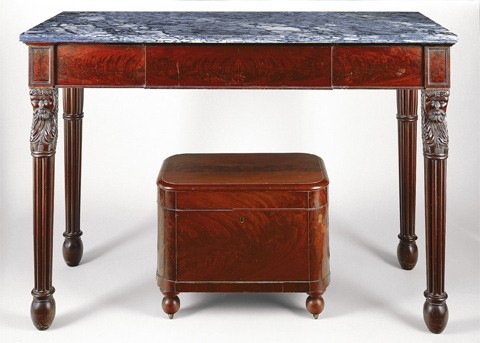
Pier table and liquor case by Edward Priestley, Baltimore, Maryland, 1827. Pier table: mahogany with yellow poplar and white pine; marble. H. 42 3/4", W. 62", D. 26 3/4". Liquor case: mahogany with yellow poplar, white pine, and mahogany. H. 20 1/4", W. 26 1/2", D. 17 1/2". (Private collection, photo, Gavin Ashworth.) Although the smooth, rounded surfaces of the liquor case contrast with the rectilinear form and carved and reeded decoration on the pier table, similar incongruities are prevalent in design book illustrations for these forms. See Thomas Hope, Household Furniture and Interior Decoration (1807), pls. 13, 15, 22.
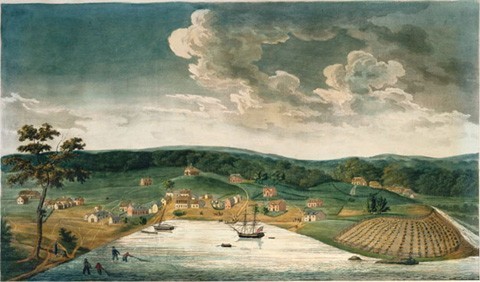
Daniel Bowley, Esq., Baltimore in 1752, From a Sketch Made by John Moale, Esq., Baltimore, Maryland, 1817. Aquatint. Dimensions not recorded. (Courtesy, Maryland Historical Society.)
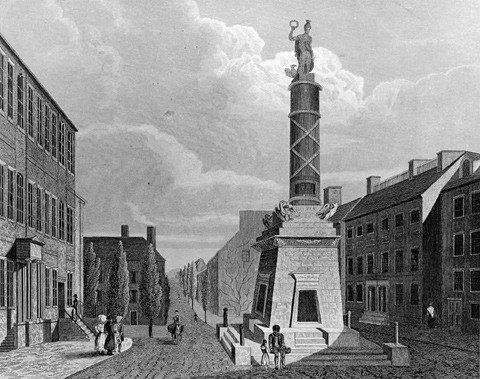
W. Goodhue, Jr., Battle Monument, Baltimore, issued by Archer & Boilly, New York, c. 1831. (Courtesy, Winterthur Museum.)
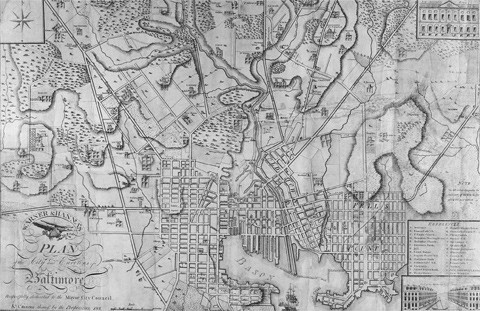
Warner & Hanna’s Plan of the City and Environs of Baltimore, engraved by Francis Shallus, Philadelphia, 1801. Dimensions not recorded. (Courtesy, Winterthur Museum.) In 1801, Baltimore and its environs included Baltimore-Town, Fell’s Point, and Jones Town. Warehouses were located close to the water, which was the city’s economic nucleus, and commercial establishments were situated to the north and concentrated around Baltimore (or Market) Street.
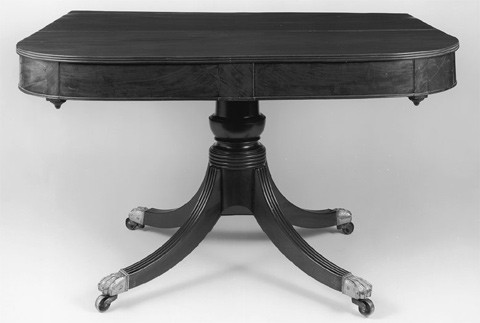
End of a three-part dining table attributed to Edward Priestley, Baltimore, Maryland, 1810–1815. Mahogany with yellow poplar and oak. H. 28 3/4", W. 164" (all three sections), D. 56 3/4". (Private collection; photo, Gavin Ashworth.)
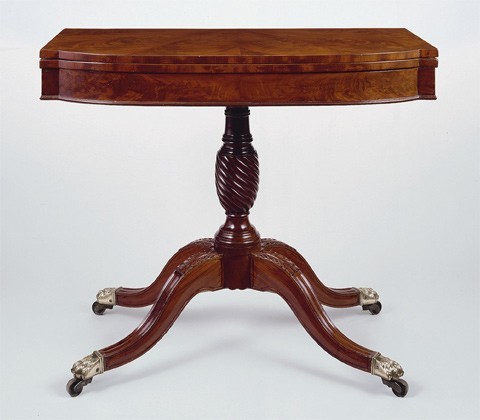
Card table attributed to Edward Priestley, Baltimore, Maryland, 1810–1815. Mahogany with yellow poplar, white pine, oak, and beech. H. 28 3/4", W. 36", D. 17 1/2". (Private collection; photo, Gavin Ashworth.)

Detail of the top and pillar of the card table illustrated in fig. 6. (Photo, Gavin Ashworth.) The top has wedge-shaped mahogany veneers that eminate from a half-round mahogany panel.
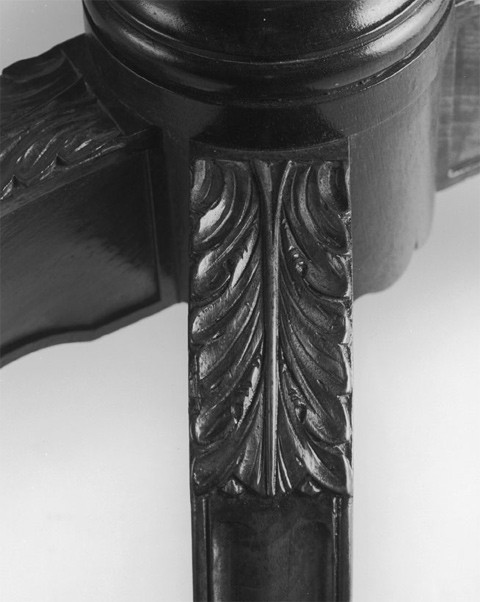
Detail of the leg molding and carving on the card table illustrated in fig. 6. (Photo, Gavin Ashworth.)
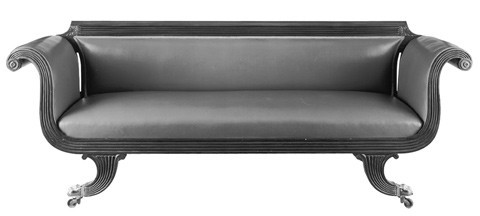
Sofa attributed to Edward Priestley, Baltimore, Maryland, 1810–1815. Mahogany with yellow poplar. H. 35", W. 96", D. 24 1/2".
(Private collection; photo, Gavin Ashworth.)
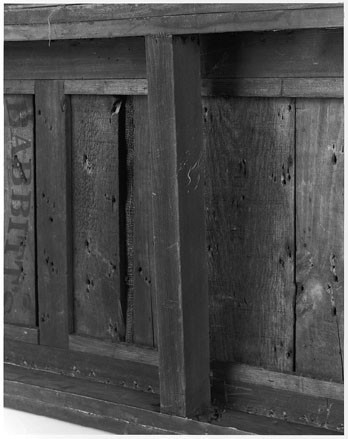
Detail of the seat frame construction of the sofa illustrated in fig. 9. (Photo, Gavin Ashworth.)
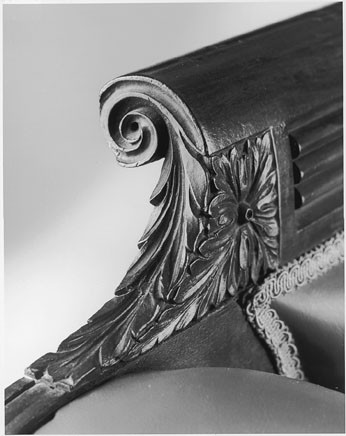
Detail of the carving on the crest rail of the sofa illustrated in fig. 9. (Photo, Gavin Ashworth.)
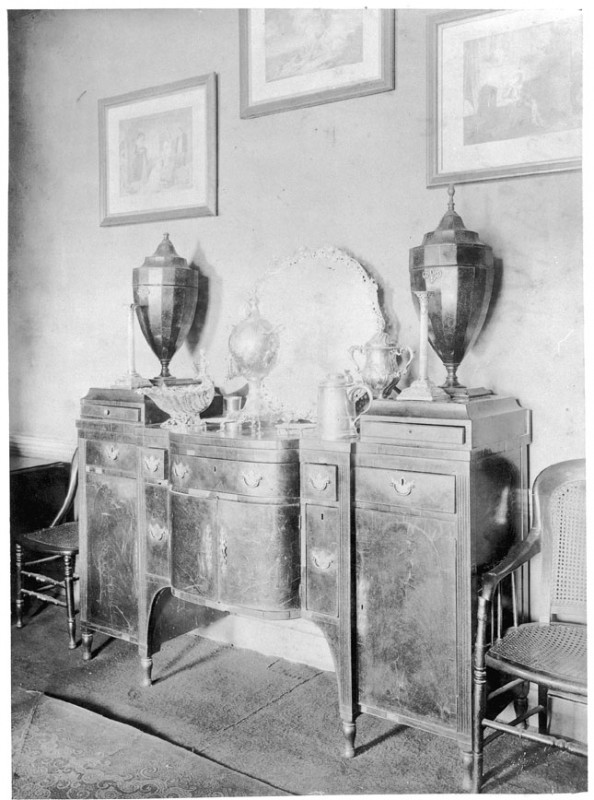
Circa 1900 photograph showing a sideboard attributed to Edward Priestley, Baltimore, Maryland, 1810–1815. (Private collection; photo,Gavin Ashworth.)
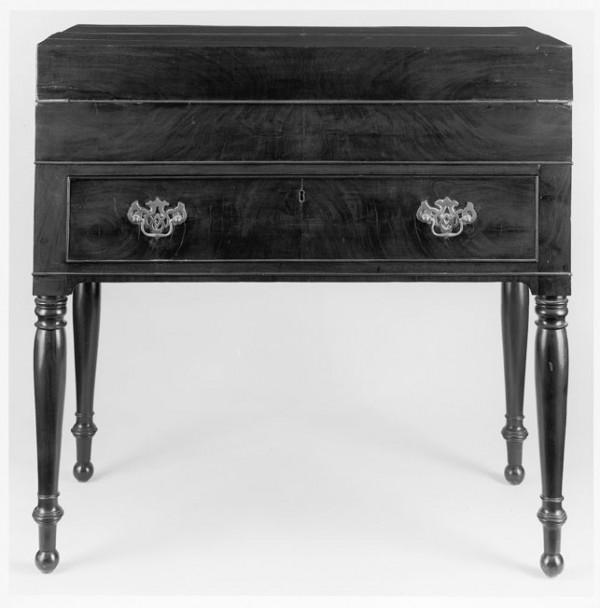
Writing desk attributed to Edward Priestley, Baltimore, Maryland, 1810–1815. Mahogany with yellow poplar and white pine. H. 36", W. 36", D. 17 3/4". (Private collection; photo, Gavin Ashworth.)
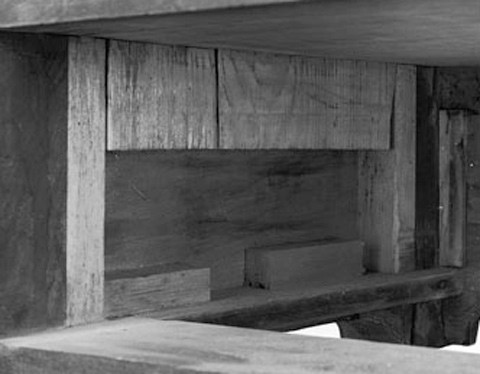
Detail showing the attachment of the desk and table sections of the writing desk illustrated in fig. 13. (Photo, Gavin Ashworth.)
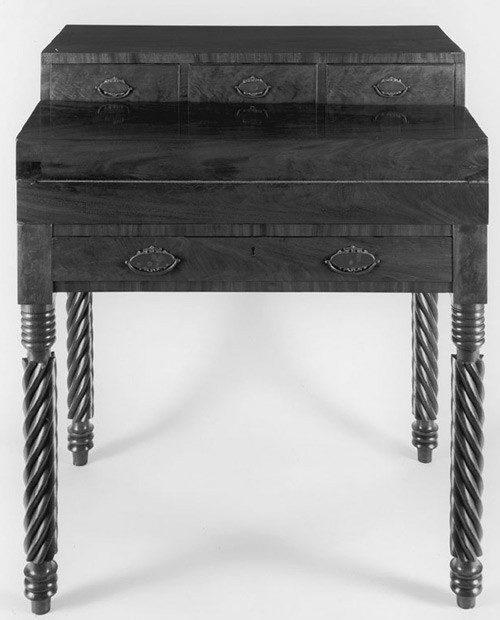
Writing desk attributed to Edward Priestley, Baltimore, Maryland, 1810–1815. Mahogany with yellow poplar and white pine. H. 37", W. 32", D. 32 1/4". (Courtesy, Baltimore Equitable Society; photo, Gavin Ashworth.)
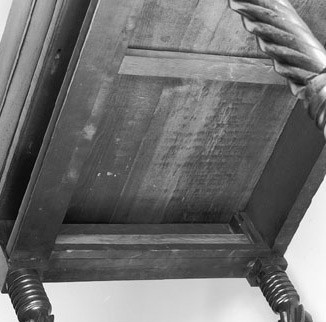
Detail showing the attachment of the desk and table sections of the writing desk illustrated in fig. 15. (Photo, Gavin Ashworth.)
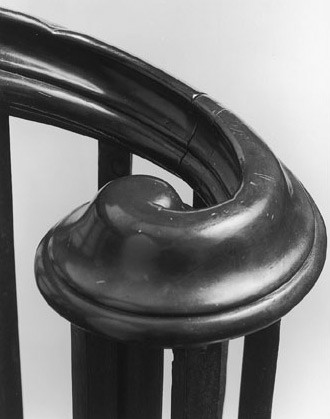
Section of handrailing by Edward Priestley, Baltimore, Maryland, 1826. (Photo, Gavin Ashworth.)
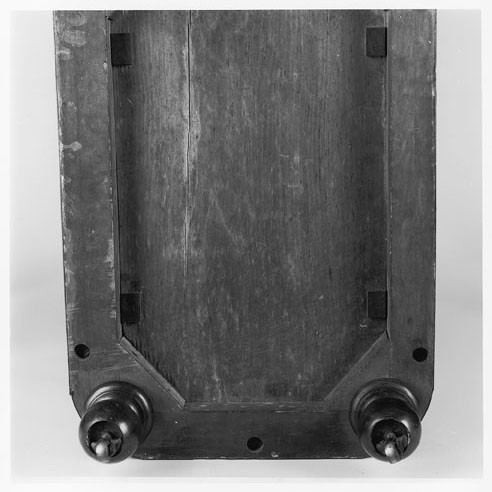
Detail of the base construction of the liquor case illustrated in fig. 1. (Photo, Gavin Ashworth.)
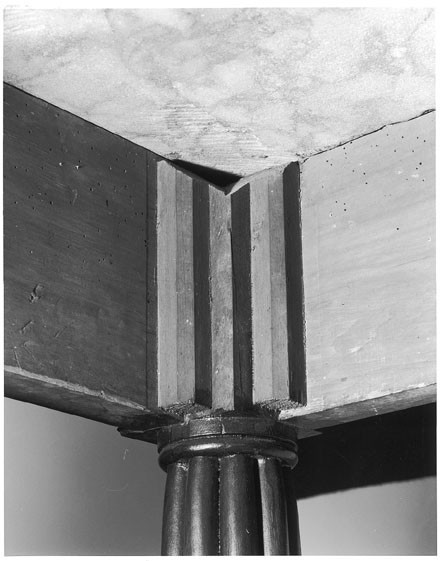
Detail of the glue blocks on the pier table illustrated in fig. 1. (Photo, Gavin Ashworth.)
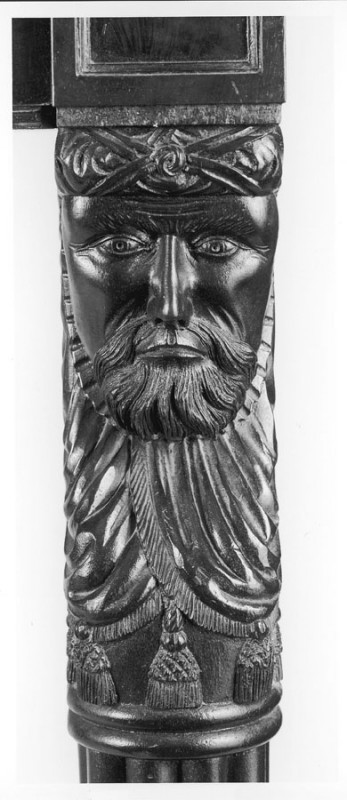
Detail of the carved mummy head on the right front leg of the pier table illustrated in fig. 1. (Photo, Gavin Ashworth.)
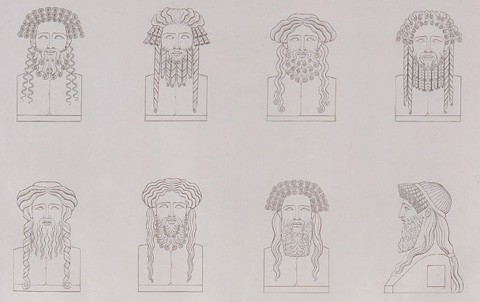
“Indian or Bearded Bacchus” designs illustrated on plate 57 of Thomas Hope’s Household Furniture and Interior Decoration (1807). (Courtesy, Winterthur Library, Printed Books, and Periodical Collection.)
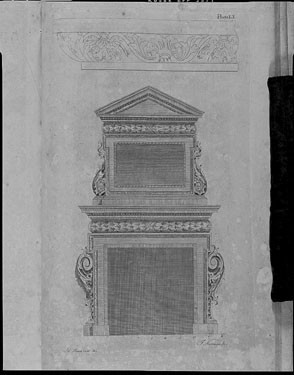
Design for a chimney piece illustrated on plate 52 of Abraham Swan’s The British Architect or, The Builder’s Treasury of Staircases (1758). (Courtesy, Winterthur Library, Printed Books, and Periodical Collection.)
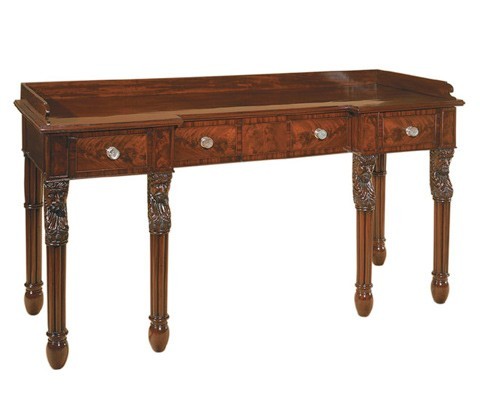
Sideboard table attributed to Edward Priestley, Baltimore, Maryland, 1825–1835. Mahogany with yellow poplar, oak, and mahogany. H. 39 3/4", W. 82 1/4", D. 27 1/2". (Private collection; courtesy, Hirschl and Adler Galleries.)
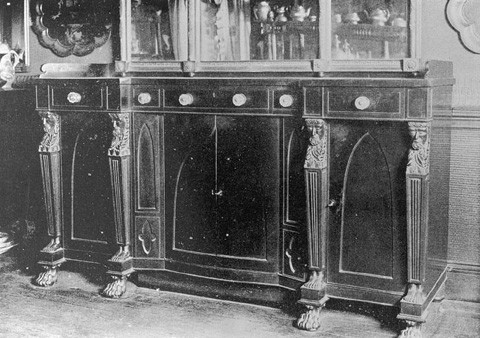
Sideboard attributed to Edward Priestley, Baltimore, Maryland, 1825–1835. Dimensions and woods not recorded. The sideboard was lot no. 107 in O. A. Kirkland’s Catalogue of the Celebrated Dr. William H. Crim Collection of Genuine Antiques (1903).
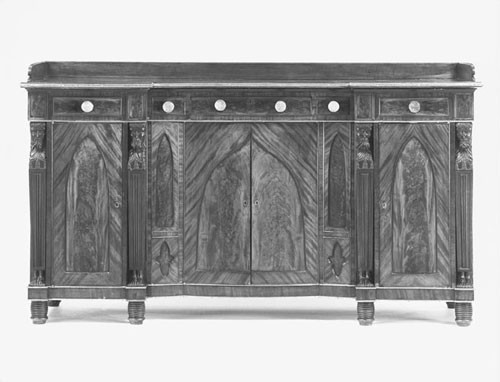
Sideboard attributed to Edward Priestley, Baltimore, Maryland, 1825–1835. Mahogany with yellow poplar, yellow pine, and mahogany. H. 46 3/4", W. 82 1/4", D. 27 1/2". (Courtesy, Baltimore Museum of Art.) The sideboard is comprised of three dovetailed cases that rest on a joined frame. The right pedestal is fitted with a round revolving bottle holder.

Detail of a mummy head on the sideboard illustrated in fig. 25.
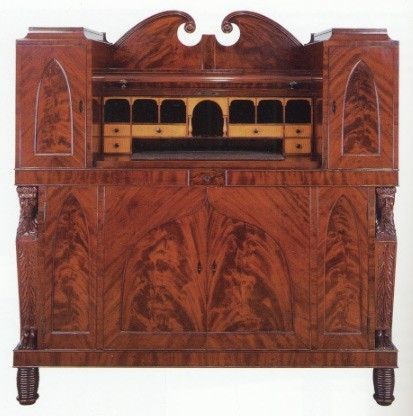
Desk attributed to Edward Priestley, Baltimore, Maryland, 1825–1835. Mahogany, satinwood, and ebony with yellow poplar, white pine, and mahogany. H. 56 3/4", W. 54", D. 22 1/4". (Courtesy, Maryland Historical Society; photo, David Prencipe.)
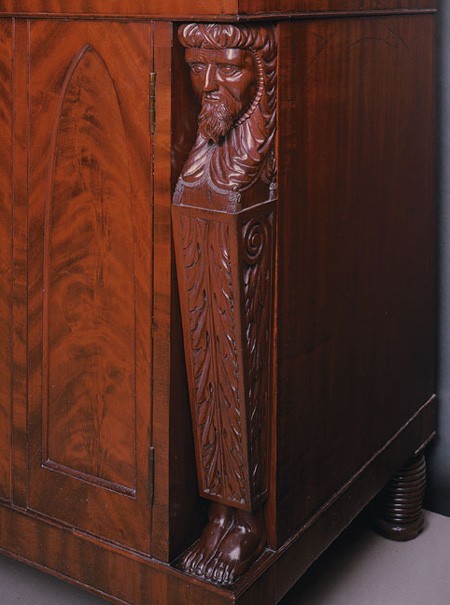
Detail of the mummy head and therm on the right side of the desk illustrated in fig. 27.
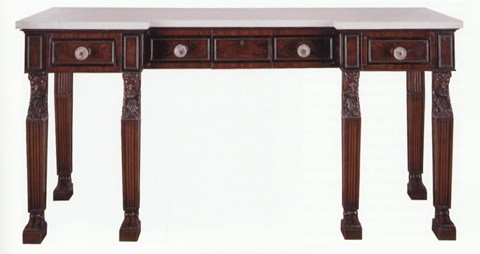
Sideboard attributed to Edward Priestley, Baltimore, Maryland, 1825–1835. Mahogany with yellow poplar and white pine; marble. H. 40", W. 82 1/4", D. 24". (Courtesy, Andalusia Foundation; photo, Gavin Ashworth.)
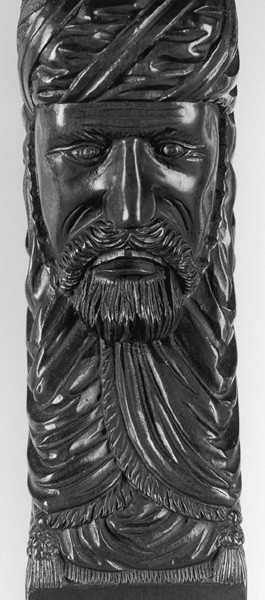
Detail of a mummy head on the sideboard illustrated in fig. 29. (Photo, Gavin Ashworth.)
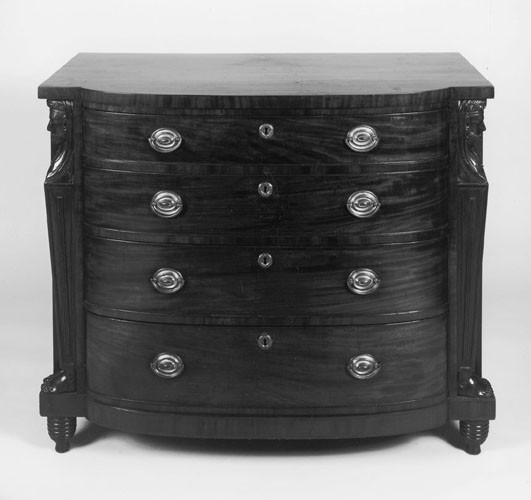
Chest of drawers attributed to Edward Priestley, Baltimore, Maryland, 1825–1835. Mahogany. Secondary woods and dimensions not recorded. (Courtesy, Sotheby’s.)
The paucity of documented examples of late-eighteenth- and early-nineteenth-century Baltimore furniture and manuscripts such as cabinetmakers’ account books and day books has left decorative arts historians with few clues to link individual pieces with their makers, even though the city’s cabinetmakers and chairmakers produced thousands of objects during that period. Most attributions to specific artisans and shops are based on widely pervasive structural and stylistic details shared by objects documented to a small number of artisans. Although this methodology can produce convincing results, it must be employed with considerable care when assessing furniture from large urban areas. In cities like Baltimore, artisans routinely moved from shop to shop taking their design and construction vocabularies with them. This migration of style and structure makes many traditional attributions to Baltimore cabinetmakers problematic.
A recently discovered receipt from Baltimore cabinetmaker Edward Priestley (1778–1837) to Talbot County, Maryland, planter Edward Lloyd VI (1798–1861) is the first document illuminating the work of this important southern tradesman. Listed on the 1827 receipt are a marble-top pier table and an accompanying liquor case (fig. 1) that remain among the furnishings in Wye House (built 1787), the Lloyd family’s home in Talbot County. The mummy head supports of the pier table serve as a benchmark for attributing two sideboard tables, three sideboards, three chests of drawers, and three desks to Priestley’s shop and for separating Baltimore and Philadelphia case and tables forms with this distinctive detail. Compounded from Egyptian, Gothic, and French influences, Priestley’s dramatic mummy heads represent one of the most expressive and highly developed manifestations of the late neoclassical style in American furniture.
Account books and receipts reveal that Edward Lloyd VI’s father Edward V (1779–1834) patronized Priestley exclusively for cabinet work between 1801 and 1825. This is significant given the cosmopolitan nature of certain segments of Maryland society. Wealthy consumers like the Lloyds were acutely aware of the latest European fashions. The Lloyds’ vast resources and mercantile connections gave them access to the finest imported goods and to local tradesmen who were eager to fulfill any request. Although over 216 furniture makers worked in Baltimore during the first three decades of the nineteenth century, the Lloyds—Maryland’s most culturally influential family—clearly favored Priestley. Priestley began his career during an unprecedented period of economic growth in Baltimore (figs. 2, 3). With an excellent harbor and a vast grain-producing hinterland, the city dominated the wheat trade in the middle Atlantic region after the Revolution. When Priestley arrived in Baltimore in 1790, the city had 13,000 inhabitants. By the time he opened his shop in 1801, the population had grown to 26,514. Nine years later Baltimore had 45,000 inhabitants, a population second only to New York.
During the late eighteenth and early nineteenth centuries, Baltimore’s thriving economy attracted furniture makers from Britain, continental Europe, the West Indies, and the Atlantic seaboard. By the early 1800s, the convergence of English, Scottish, French, German, Irish, West Indian, and American traditions had given Baltimore furniture its own distinctive identity. On June 28, 1817, John Howe’s Baltimore Carpet, Furniture, and Looking Glass Warehouse advertised “sideboards of Boston, New York and Baltimore styles.” Established cabinetmakers and newcomers vied for the patronage of merchants, gentlemen, and professionals and endeavored to compete with furniture imported from other American cities and from abroad. It was within this climate that Edward Priestley’s cabinetmaking business thrived.[1]
Edward Priestley’s Early Career and Partnership
Edward Priestley was born in Annapolis in 1778 and arrived in Baltimore in 1790 with his mother, Mary Ann (1749/50–1835.) By 1780, Baltimore had eclipsed Annapolis socially, culturally, and economically. In 1793, New York lawyer James Kent noted that Baltimore had experienced “the most rapid growth of any town” in the United States:
Howe’s going to Phil[adelphia] in 1777 . . . diverted the [backcountry grain] . . . trade to Baltimore. The [yellow fever] Sickness in Phil[adelphia] . . . last Fall has done the same, & Baltimore this season will nearly rival Phil[adelphia] in the export of wheat & Flour. . . . [Baltimore] is built chiefly of brick. Its Houses are 3 Story-join[ed] together—are wide, & the Town appears to be better and more handsomely built than Phil. In 1760 there were not 10 brick Houses, whereas in 1787 It had 2000 Houses in the whole of which 800 were at Fell’s Point, & had 152 Stores. It has grown rapidly since, & has now perhaps 13,000 Souls. It is larger than Charlestown, but does not yet equal Boston. . . . In 1760 Baltimore was 10 times inferior to Anapolis, & was a paltry Village. From 1770 it took a Spring, & grew 100 fold in 1774.[2]
Priestley probably served his apprenticeship in Baltimore between 1790 and 1801; however, the identity and location of his master remain unconfirmed. By December 1801, he had formed a partnership with cabinetmaker Samuel Minskey (1778–1819) of “Baltimore Town.” The latter was the son of Annapolis carpenter Nicholas Minskey and, like Priestley, he had lost his father at an early age. Referred to as “orphans” during the period, fatherless males who apprenticed in the cabinetmaking trade generally began serving their terms at sixteen years of age. Minskey, for example, signed an indenture with Baltimore cabinetmaker Nicholas Kirby in 1794. According to furniture historian John Henry Hill, most Baltimore cabinetmaking partnerships involved unrelated tradesmen who had apprenticed with the same master. Although these partnerships rarely lasted more than three years, they allowed young artisans to combine capital to purchase tools and materials and rent shop space. It is therefore quite plausible that Priestley also apprenticed with Kirby.[3]
Priestley and Minskey’s shop was located at 79 Water Street between the main commercial street and the bustling wharves in Baltimore Town (fig. 4). Their neighbors were cooper Griffith Evans and John Stickney & Company’s turpentine distillery. Further east on Water Street were fellow cabinetmaker William Camp (1773–1822) and the firm of Coleman & Taylor. In 1802, Priestley and Minskey published their first and only advertisement, thanking the public for “the liberal encouragement” they had received. Their stock included sideboards, “secretaries and bookcases,” fall-front desks, “circular and straight front bureaus,” circular and “sash corner” card tables, “Northumberland” dining tables, oval and square pembroke tables, and square and circular basin stands, all available at “the most reduced prices.” Although Priestley and Minskey described themselves as “chair-makers” on one occasion, it is doubtful that they made much seating furniture. Evidence suggests that they subcontracted chair work to specialists including Francis Younker (fl. 1807–1833) and Jacob Daley (fl. 1804–1848). This practice was common in the furniture-making trades in most urban centers.[4]
Like many of their contemporaries, Priestley and Minskey engaged in the furniture export trade. On December 15, 1802, the Georgia Republican and State Intelligencer reported that “the ship Comet . . . from Baltimore” had just arrived in Savannah with a cargo of “excellent mahogany furniture” and “a few fancy chairs. . . . Any person Wishing to purchase bedsteads, or any article in the above line” could be “supplied in a few weeks by Edward Priestly, At Johnson and Robertson & Co.’s old Compting Hou[se].” The fancy chairs mentioned in this advertisement support the notion that Priestley and Minskey farmed out orders for seating furniture. Several Baltimore chairmakers specialized in the production of “fancy chairs.” Matthew McColm (fl. 1803–1850), for example, worked just down the street from Priestley and Minskey and shipped fancy chairs to Savannah. Baltimore chairmakers John and Hugh Finlay (fl. 1799–1834) and Jacob Daley also exported fancy chairs and all three were acquainted with Priestley.[5]
In the January 1, 1803, issue of the Columbian Museum and Savannah Advertiser, Priestley stated that he was returning to Baltimore and wished to dispose of his remaining secretaries, bureaus, portable desks, card tables, oval pembroke tables, candle stands, bedsteads, and Windsor chairs. He also offered to execute subsequent orders “in the best manner” and deliver the furniture “in Savannah, at Baltimore prices.” The latter phrase suggests that Priestley ’s furniture was less expensive than that imported from New York, Salem, and Philadelphia and that his Savannah patrons recognized it. The proximity of Baltimore to Savannah may have given Priestley a competitive edge. His shipping costs must have been less than those of many northern cabinetmakers who engaged in the furniture export trade.[6]
In 1806, Priestley and Minskey moved their shop to Baltimore Street at Philpot’s Bridge, which spanned Jones Falls and linked Baltimore Town to Fell’s Point and Old Town or Jones Town. The Baltimore Directory for 1804 described Baltimore Street as the “principal” one in the city. It extended from east to west, was over a mile long, and provided access to 430 warehouses, stores, and dwellings. Ship passengers arriving in Baltimore disembarked at the wharves in Fell’s Point. To enter the commercial center of Baltimore Town, visitors passed through Fell’s Point and crossed Philpot’s Bridge. The first shop on the left was Priestley and Minskey’s. This location—on a busy thoroughfare in the center of Baltimore’s cabinetmaking community—provided excellent exposure to both newcomers and established elites. It also gave Priestley and Minskey access to tradesmen from whom they could commission piecework or specialized forms such as chair frames.[7]
Priestley and Minskey took four apprentices between 1801 and 1807. John Johnson began his term in October 1801. Merchant Mark Pringle, whose business was east of Priestley and Minskey on Water Street, was a party in the agreement. As a respected and prominent member of Baltimore society, Pringle often guaranteed people’s credit. Priestley and Minskey’s remaining apprentices signed indentures in 1807—George Plaines in May and John Bringman and Joseph Hutton in October. Like Priestley and Minskey, all of their apprentices were orphans.[8]
On March 18, 1803, Priestley and Minskey signed a petition circulated by the Cabinet-Makers and Manufacturers of Mahogany in the City of Baltimore. This petition, which was approved by the city on March 22, advocated more stringent requirements for inspecting and grading mahogany. Among the nineteen cabinetmakers and firms that joined the appeal were William Camp; Walter Crook; Michael Jenkins; James Martin; James Davidson; Coleman & Taylor; Nathaniel Hynson, Sr.; Warrick Price; Law & Denmead; and Stitcher & Clemmens. After only three years of being in business, Priestley and Minskey were allied with the most prosperous cabinetmakers in Baltimore.[9]
On November 20, 1807, the Federal Gazette reported that Priestley and Minskey had dissolved their partnership and that Priestley intended to continue the cabinetmaking business at 4 Baltimore Street—a location he maintained until his death in 1837. Minskey established a cabinetmaking business around the corner on Saint Patrick’s Row. He remained there until 1812, when he returned to Anne Arundel County.[10]
Priestley’s Cabinet Shop, 1807–1837
During his career, Priestley adapted to stylistic and economic changes by modifying his business practices and the furniture forms he produced. This flexibility enabled him to compete with other Baltimore cabinetmakers as well as with furniture imported from abroad. Priestley advertised only twice, yet documents reveal that he enjoyed the patronage of Maryland’s most prominent families. Recommendations and referrals by satisfied customers undoubtedly contributed to his success.
On November 20, 1807, the Baltimore American and Commercial Daily Advertiser reported that Priestley had on hand “an elegant assortment of furniture” along with “a quantity of St. Domingo and Bay MAHOGANY, fit for Cabinet Makers and House Carpenters.” The furniture forms listed in the advertisement duplicated those offered by Priestley and Minskey years earlier, with the exception of a “Pedestal end Side Board, With a pair of Superb Vase Knife Cases.” A subsequent advertisement that appeared in the Baltimore Evening Post and Baltimore Whig provided a more detailed description of Priestley’s stock:
Pedestal end side boards, kidney, commode and straight do.; SECRETARY and BOOK CASES; WARDROBES; BUREAUS of different shapes; Card Tables; North-Umberland Dining Tables, in setts; pillar and claw Breakfast Tables; oval and square ditto; Wash-stands of all kinds; Work Tables; Portable Desks; fashionable Sophas; and Mahogany Bedsteads, complete with Steps, Poplar do.[11]
Priestley’s statement that these items were among “a great variety” of furniture “on hand at his manufactory” is significant. Although he clearly maintained a large stock in trade, Priestley did not operate a warehouse or separate wareroom like many of his competitors. Baltimore directories consistently refer to his business as a “cabinetmaking shop.”[12]
The range of forms specified in Priestley’s advertisements and his reference to other furniture “in this line” suggest that he employed a large and highly skilled workforce. Several of his contemporaries relied heavily on apprentice labor. William Camp, for example, took fifty-three apprentices between 1801 and 1822 and Jacob Daley took eighteen between 1804 and 1816. By comparison, only four apprentices bound to Priestley appear in Baltimore records from 1807 to 1837. Although his workforce clearly included unregistered apprentices, Priestley’s shop apparently had a higher percentage of journeymen and indentured tradesmen.[13]
The renowned cabinetmaker John Needles (1786–1878) began his Baltimore career in Priestley’s shop. According to Needles’s autobiography, he arrived in Baltimore in 1808 and worked for Priestley for six months before signing an indenture with William Camp. Although Needles already had served a five-year apprenticeship with James Neale (fl. 1780–1810) of Easton, his skills may not have met Priestley’s requirements. Needles subsequently established his own shop, which flourished from 1810 to 1852.[14]
From 1816 to 1817, Priestley employed journeyman Henry Lusby (1782–1867), who had completed an apprenticeship with Annapolis cabinetmaker John Shaw (1745–1829) in 1811. Lusby and Priestley remained friends long after severing their business ties. When respiratory problems forced Lusby to close his cabinetmaking business, Priestley and turner William Roney (1782–1844) wrote a letter to the city of Baltimore stating that Lusby’s “arduous military duties” affected his lungs, making him unable to work near mahogany dust. City officials accepted their plea and made Lusby a hay weigher for Baltimore in 1818.[15]
Because Priestley is not listed in any federal census from 1800 to 1830, it is impossible to determine the number or status of individuals living in his house and working in his shop. At his death, he owned “one Negro named Henry about 30 years old to serve about 3 years . . . $150.00.” It is possible that Henry was in the process of purchasing his freedom by working for Priestley.[16]
At least two independent tradesmen worked in Priestley’s shop. The precise nature of their business arrangement is not known, but it is possible that these artisans provided Priestley with piecework or specialized forms in lieu of rent. In 1810, chairmaker Francis Younker began advertising that he made and exported fancy chairs out of Priestley’s shop. Younker established his own shop in Old Town in 1824, the same year that upholsterer John L. Scott began working at Priestley’s address. The sharing of premises was relatively common among Baltimore furniture makers. Chairmaker Matthew McColm worked out of Coleman &Taylor’s shop from 1800 to 1804 and upholsterer Armistead Green worked out of John Needles’s Hanover Street cabinetmaking manufactory from the late 1820s to the 1840s.[17]
Although most of the tradesmen who worked in Priestley’s shop remain anonymous, the approximate size of his workforce can be inferred from the number of workbenches he owned at a given time. During the eighteenth and nineteenth centuries, shop masters were responsible for furnishing their workmen’s benches. Laborers rarely shared their workspaces despite the fact that benches were quite expensive. Considering the number of apprentices, journeymen, and indentured tradesmen associated with him, Priestley must have had at least a half-dozen benches within one or two years of opening his shop. In 1823, he purchased thirty-one workbenches from William Camp’s estate, and at his death in 1837 he owned twelve. This suggests that Priestley’s workforce ranged from approximately six to more than thirty individuals.[18]
Priestley’s Ancillary Businesses
Unlike many of his contemporaries who endeavored to expand their businesses by opening warehouses or engaging in the furniture export trade, Priestley invested in lumber, real estate, railroad stock, nail manufacturing, and wharf and ship construction. Several of these ventures, in turn, broadened his market for raw materials and furniture. In the end, these investments generated twice the income of Priestley’s cabinet shop. When he died in 1837, Priestley owned twelve shares of Baltimore & Ohio railroad stock and six city lots. The combined value of these investments comprised 63 percent of his estate, which totaled $20,523.37. The remaining 37 percent included a huge stock of lumber, finished and unfinished furniture, tools, cabinetmaking supplies, and personal effects (see appendix).[19]
Priestley may have become involved in Baltimore’s iron industry as early as 1807, when he appeared before the chancery court as a trustee for the estate of blacksmith Duncan McCollum. In November of that year, the American and Commercial Daily Advertiser reported that Priestley had sold McCollum’s real estate for fourteen hundred dollars and that he was able to settle the blacksmith’s debts. By 1820, Priestley had entered into partnership with Enoch and Elizabeth Betts, who operated a nail manufactory in Old Town, just over Philpot’s Bridge from Priestley’s shop. The Betts supplied nails to many Baltimore furniture makers.[20]
Priestley made his first foray into the lumber business on November 20, 1807, when he advertised mahogany in the American and Commercial Daily Advertiser. Three years later, he and cabinetmakers Walter Crook and Michael Jenkins offered “18,000 feet of ‘bay’ mahogany . . . particularly selected for the London market.” Early tradesmen often pooled their resources to acquire large quantities of lumber or other materials. In 1816, Priestley, Jenkins, Crook, and William Camp purchased 260 mahogany logs from the ship John Hamilton. In a subsequent advertisement, they reported that the logs were particularly well suited for cabinetmakers owing to their superior grain and color. After 1816, Priestley financed his own lumber deals. His advertisements in Baltimore and Washington newspapers offered discounts to any purchasers who would pick up their lumber from the wharves where it was unloaded. Priestley’s references to “good table wood” and “hand rail mahogany in prime order” reveal that he understood the properties of various types of timber and was able to provide the best materials for his clients.[21]
Most of Priestley’s shipbuilding and wharfing ventures took place across Philpot’s Bridge in Old Town. In the July 21, 1809, issue of the Whig, he reported that he owned a new packing machine for sealing the horizontal planks in ships and advertised for a workman to operate it. He also offered to lease the machine on terms as “low or lower . . . than any other in the City.” Priestley took work orders for wharf carpenters William Fisher in 1810 and Jehu Brown in 1815. Fisher advertised that he owned the latest in piling machines, “with iron hammers in complete order,” whereas Brown offered a wide variety of timbers for wharfing. Priestley may have loaned both men the capital to purchase their machinery and materials in hopes of generating more business for their joint ventures. At the very least, Priestley’s various businesses gave him access to merchants, ship captains, and other individuals who could help him acquire and transport lumber and market his furniture in other locales.[22]
Priestley’s real estate holdings were his most significant and lucrative investment. His advertisements for dwellings, commercial spaces, and ground lots first appear in Baltimore newspapers in 1810. That same year, he enrolled his properties on Front Street in a fire insurance policy from the Baltimore Equitable Society. Using rental income, Priestley periodically acquired additional property. In 1834 he purchased eight adjacent dwellings on Forest and Boglap Streets in Old Town. Many of Priestley’s tenants and debtors were tradesmen, including cabinetmaker Levin Pritchett, cooper Joseph Armiger, carpenter Joseph Stubbs, carpenter Hiriam Tolson, and wharfer James Thompson (see appendix).[23]
Priestley’s Clients
Although the nature of the debts owed to Priestley’s estate was not usually specified, the names on the list reveal a great deal about the status of his clients and colleagues. Fellow tradesmen were probably indebted to him for credit he had extended or for goods they had purchased from his shop, whereas most of his tenants simply owed their last month’s rent. The responsibility for recovering the debts fell on Priestley’s executors—chairmaker and friend Jacob Daley, printer and publisher Thomas Murphy, and attorney Reverdy Johnson. The executors divided the debts into three categories: “Sperate,” “Doubtful,” and “Desperate.” Priestley’s debtors were dispersed throughout Baltimore with the heaviest concentration being in the neighborhood around his shop and home, just northeast of 4 Baltimore Street. The most numerous debtors were fellow cabinetmakers and artisans involved in other woodworking trades.
Lumber dealers on the list were H. Herrington, Job Smith, John Wilson, William H. Bates, Griffith Evans, J. Sleppy, Edward Dowling, and Timothy Richards. Each lived near Priestley and owed him a fairly insignificant sum. Herrington was obligated to pay his fifty-dollar debt in lumber.[24]
The cabinetmakers and chairmakers indebted to Priestley were dispersed throughout Maryland. Washington G. Tuck, for example, was an Annapolis cabinetmaker, as was Daniel Dashiell, who had trained with William Camp in Baltimore. By contrast, cabinetmaker Joseph J. Thomas lived and worked near Priestley and is likely the same Joseph Thomas who became a turner in the late 1830s and early 1840s. Other cabinetmakers on the list are James Askey, James Billington, Henry Dukehart, George McCoull, Levin Pritchett, Charles Suter, and Samuel Thompson. Billington’s debt of $405.33 was the largest of any cabinetmaker on the list. Chairmakers who owed Priestley money included Jacob Daley, John Robinson, and Francis Younker’s former apprentice, James Pennington.
Priestley’s list of debtors documents his involvement with other artisans in the furniture-making trades as well as merchants and businesses that catered to them. Thomas C. Sholes was a principal in Davis & Sholes Upholsterers; Robert L. Porter and John A. Diffenderfer were hardware merchants; Edward Lynch of Lynch & Craft was a merchant specializing in paint; and Edward Patterson of J., W., & E. Patterson was an iron merchant. Debts owed by commission merchants and auctioneers also represent a significant portion of Priestley’s estate.[25]
Priestley’s clients included many socially prominent and politically powerful individuals from Maryland and the District of Columbia. President and Mrs. James Madison ordered a pair of card tables and a breakfast table from Priestley in 1815. Edward Lloyd V and Edward Lloyd VI were proprietors of Maryland’s largest plantation. Edward V, who served as governor, congressman, and senator, was related to many of Priestley’s other patrons including the Goughs, Carrolls, and Nicholsons. Like many of their social peers and relatives, Edward V and Edward VI purchased most of their furniture from Priestley rather than from northern, French, or English cabinetmakers. Charles Carnan Ridgely (1760–1829), for example, purchased $264.62 worth of mahogany furniture from Priestley for his house Hampton in 1812.[26]
Lawyer and judge Roger Brook Taney (1777–1864) owed Priestley $30.25. Taney was admitted to the Maryland bar in 1799 and subsequently served as attorney general and secretary of the treasury during President Andrew Jackson’s administration. In 1835, Taney succeeded John Marshall (1755–1835) as chief justice of the United States.[27]
The estate of Baltimore merchant Robert Oliver (1757–1834) also appears on Priestley’s list of debtors. Among the wave of British merchants who arrived in the city after the Revolution, Oliver immediately established a lucrative business with Hugh Thompson and his brothers. Oliver dealt with European and Asian merchants and later profited from investments in real estate and railroads. His 1834 estate, which was valued at over $357,000, included a townhouse in Baltimore and two country seats, Green Mount and Harewood. All of Oliver’s homes were filled with elaborate silver and furniture, some of which may have come from Priestley’s shop.[28]
Baltimore banker George Brown owed Priestley’s estate twenty-four dollars, although the latter’s executors noted that the debt was probably unrecoverable. Brown’s father Alexander (1764–1834) founded the banking firm of Alexander Brown & Sons in 1800. A sideboard with mummy heads similar to those on furniture from Priestley’s shop was in Alexander’s house, Mondawmin, just outside the city.[29]
John Glenn (d. 1835), a distinguished Baltimore attorney and judge for the United States District Court in Maryland, owed Priestley $49.25. Glenn owned a country house near Catonsville and a townhouse in Baltimore. The sideboard illustrated in figure 29 may have been among the original furnishings of one of these houses. It evidently descended to his granddaughter Letitia (1864–1910), who married Charles Biddle (1857–1923) in Baltimore on April 4, 1888. The piece remains in the Biddle’s home Andalusia, located just north of Philadelphia.[30]
A few of the entries in Priestley’s list of debtors note the furniture forms involved. Charles Carroll Ridgley’s estate owed twenty-four dollars for a coffin for his infant son and Henry B. Chew owed thirty-one dollars for a coffin for his wife Harriet (Ridgley). The price of Priestley’s coffins evidently varied based on their size, materials, and detail. Robert Scroggs’s coffin, for example, cost only twelve dollars. Monsieur Pageott and Baron de Beher each owed sixteen dollars for a chair, and Mrs. H. Armstrong owed ten dollars for a bedstead.[31]
Priestley’s Inventory
Priestley’s inventory provides a patent view of a large Baltimore cabinetmaking shop from the early nineteenth century (see appendix). The document begins with household furnishings, which included a secretary-and-bookcase, bureau-and-bookcase, card table, pier table, wardrobe, sideboard, sofa, eight-day clock, and sixty-eight books, valued at fifteen dollars. Considering Priestley’s extensive use of sophisticated English and French details, it is likely that furniture design books were among these volumes. To lay out these designs, Priestley and his workmen used “patterns and cullings,” a group of which were valued at five dollars by his executors.
Although the size of Priestley’s shop evidently diminished during his later years, he owned several sets of tools, twelve workbenches, four glue pots, and a variety of specialized implements at his death. His inventory also lists hinges for card tables, regular tables, beds, French beds, portable desks, and “Duro” chairs, and an assortment of castors, screws, bolts, and handles. To finish the furniture, he had three types of varnish totaling eighty-three gallons. The ochre listed on Priestley’s inventory may have been used for “pinking”—a slightly opaque red wash commonly found on eighteenth- and nineteenth-century British and American furniture. Pinking most often appears on the inside backboards of desk-and-bookcases and on the secondary surfaces of writing and dressing compartments. The hardware in Priestley’s inventory included glass knobs, bedstead caps, plated handles, and brass ferrets—strips or tapes—for bedposts. This last item and three pieces of furniture attributed to Priestley’s shop indicate that he occasionally used brass ornament on his furniture, a feature not commonly associated with Baltimore cabinetmaking. Like many cabinetmakers, Priestley performed a considerable amount of undertaking work. His inventory lists three cooling boards, thirteen coffin plates, black muslin, and 22,000 brass nails. He also owned a variety of upholstery materials including 200 pounds of curled hair, 20 pounds of duck feathers, duck cloth, and over 215 yards of hair cloths, bed cords, sacking bottoms, and mattresses.
The finished and unfinished furniture listed in Priestley’s inventory provides a more extensive view of his shop’s production than the objects listed here. Beds, which were the most numerous furniture form, included examples described as “high post” (eleven), “low post” (fifteen), “French” (seven), “trundle” (four), “cradle” (ten), and “crib” (four). The appraisers also divided the tables into several categories: undescribed or “pine” tables (fourteen), “dining” tables (four), “sett [of] extension tables” (one), “breakfast” tables (one), “centre” tables (two), pairs of “card” tables (five), “dressing” tables (one), and “pier” tables (one). Washstands, candlestands, workstands, and trays with stands accounted for nineteen of the forms in Priestley’s inventory. Case pieces comprised the smallest group of related forms and included five bureaus, three wardrobes, three desks, three sideboards, and one pedestal sideboard.
Priestley evidently was selling chairs in 1837, although it is impossible to determine whether they were commissioned by him or made in his shop. His inventory lists “chairs,” “easy chairs,” “bed chairs,” “rocking chairs,” a “close stool,” a “music stool,” and “Duro chairs”—a form that does not appear under that name in any manuscripts, inventories, design books, or price books discovered to date. References to “book arms for Duro chairs” and “screws for Duro chairs” in Priestley’s inventory suggest that the term “Duro” may have been a corruption of du roi. If so, Priestley’s “Duro chairs” may have been French-styled chairs with reclining backs and a book support attached to the seat rail or arm rail. Similar examples were illustrated in Rudolph Ackermann’s Repository of Arts, Literature, Commerce, Manufactures, Fashions, and Politics (1809–1829)—described as “Pocock’s Reclining Patent Chair”—and John Claudius Loundon’s Encyclopedia of Cottage, Farmhouse and Villa Architecture and Furniture (1833).[32]
Priestley’s Furniture
The identification of furniture from Priestley’s shop is complicated by several factors. At least four styles attained widespread popularity during his career, and he and his tradesmen undoubtedly adapted their work in response to changing tastes, cultural attitudes, and economic conditions. In addition, over 237 cabinetmakers worked in Baltimore between 1800 and 1837, many of whom produced forms similar to Priestley’s. Because he employed many journeymen over a long period of time, construction details are only marginally useful in identifying furniture from Priestley’s shop. Only when these features are considered in conjunction with documentary evidence can convincing attributions be made.
Receipts and payments made to Priestley provide information on the forms he produced, the prices he charged, and the people who patronized him. The pair of card tables and breakfast table that Priestley sold President and Mrs. James Madison must have been very elaborate for they cost eighty dollars and forty-five dollars, respectively. Even though the Madisons were ardent francophiles, their budget and political acumen may have influenced their decision to patronize an American artisan rather than purchase imported furniture. On May 5, 1815, their agent George Boyd wrote, “There can be no doubt but [furniture] . . . may be had more fashionable and cheaper [in Baltimore] . . . than in . . . [Washington] or George Town, and I only wait your commands to go there and purchase it.” Several days later Boyd purchased a dozen fancy chairs from John and Hugh Finlay and the card tables and breakfast table from Priestley, who evidently had the tables on hand since he delivered them within two weeks.[33]
Although rarely acknowledged by decorative arts historians, direct French influences were pervasive in early-nineteenth-century Baltimore furniture. Several English merchants who traded with Maryland planters during the colonial period moved to France during the 1770s and 1780s. Most maintained their transatlantic connections, exporting furnishings, fabrics, and clothing to wealthy Americans, who were becoming increasingly enamoured of French goods. French merchants also opened businesses in Baltimore after the Revolutionary War, and in 1789, the French government established a consul in Baltimore for Maryland, Virginia, and the newly formed District of Columbia. French immigrants arrived in increasing numbers after the fall of Santo Domingo in 1793 and created a Frenchtown in the western section of Baltimore. Some of these newcomers were undoubtedly tradesmen well versed in the latest Parisian styles.[34]
Baltimore consumers had embraced French styles years before the Madisons ordered their tables from Priestley. Furniture made by French emigré Charles Honoré Lannuier (fl. 1803–1819) in New York descended in the Bosley family of Baltimore and a complete set of Pierre de la Mésangère’s Collection des Meubles et Objets de Goût (1802–1835) was in the library at Hampton. When fancy chairmaker and furniture decorator Hugh Finlay returned from Europe in 1810, he advertised that he had acquired “a number of Drawings, from furniture in the first houses of London and Paris, which enable [my firm] . . . to make the most approved articles in their line.” Several forms and decorative motifs and much of the punched brass ornament on Baltimore painted furniture have direct French parallels.[35]
The appraisers of Priestley’s estate described furniture in his cabinet shop as “French,” probably owing to his production of continental-inspired forms and his use of metal appliqués. Priestley’s inventory lists seven “French” beds, six “Duro” chairs, and thirty-four brass ferrets, and three pieces of furniture attributed to his shop have brass moldings, which are common on French furniture. Priestley’s ability to work in the French style undoubtedly appealed to francophiles such as the Madisons and the French consul to America, Chevalier Marter, as well as to cosmopolitan Marylanders such as the Lloyds, Carrolls, and Ridgleys.[36]
Four pieces of Edward Lloyd V’s furniture can be attributed to Priestley’s shop based on entries in the former’s account book and his exclusive patronage of Priestley between 1801 and 1825. In March 1812 and November 1813, Lloyd recorded payments of $670.25 for “Priestley’s Bill” and $123.62 “By Edwd Priestley,” respectively. Although the furniture made by Priestley is not identified in these entries, it apparently included a dining table, Grecian sofa, pillar-and-claw card table, desk, and pedestal sideboard. All of these forms date from the early 1810s and correspond to those advertised by Priestley.[37]
The dining table (fig. 5) has book-matched mahogany leaves, thick reeded legs, and columnar pillars with truncated urns, features that occur on related forms from several other Baltimore shops. The slope of the legs and abbreviated shape of the urn turnings differ significantly from those on contemporary tables from New York, Boston, and Philadelphia. When all three sections are assembled, the dining table extends over thirteen feet. Its monumental size and rich materials complemented the other furnishings in the dining room, which included two enormous carved and gilded pier glasses that descended from Edward Lloyd III and three girandoles that Edward V ordered from England in 1810.[38]
Most of the construction details of the dining table are relatively generic, but two features differ from other Baltimore examples. The area between the legs at the base of each pillar is steeply chamfered, and the glue blocks inside the table frame are chamfered at their outer edge and beveled at the top and bottom. Identical blocks are on the pier table that Priestley made for Edward Lloyd VI in 1827 (see fig. 19).[39]
Possibly one of a pair, the pillar-and-claw card table illustrated in figure 6 has stylistic details associated with furniture made in New York, Philadelphia, and Boston, but its form is distinctly Baltimore. Its skirt is unusually deep and its core consists of four laminates, as opposed to the two or three smaller ones commonly found on northern examples. Similarly, the legs on the Lloyd table are dovetailed to a pillar rather than to a plinth. The sides of the legs have a slight bulge that creates a central spine, an unusual feature on both northern and southern work. The flat underside of the legs and cyma shaping at the base of the pillar are vestigial eighteenth-century details. Most urban cabinetmakers abandoned these features on card tables during the 1790s. The urn on the pillar of the card table (fig. 7) is not truncated like those on most Baltimore examples, although its shape does have parallels in earlier Annapolis work. A table with a similar base is illustrated in the Catalogue of the Celebrated Dr. William H. Crim Collection of Genuine Antiques (1903).[40]
The design of the carving on the knees of the card table is conventional, but the execution is idiosyncratic (fig. 8). Most of the “eyes” (the tear drop-shaped openings in front of the convex folds) between the leaves are skewed and the size of the lobes remains relatively constant from top to bottom rather than diminishing in a naturalistic manner. The quality of this carving does not approach the best work associated with Priestley’s shop, strongly suggesting that he employed more than one hand.
Grecian sofas such as the one illustrated in figure 9 were almost ubiquitous in fashionable Baltimore homes. Like most early-nineteenth-century Baltimore sofas, the Lloyd example is constructed in three sections—back, seat frame, and slip seat—and reinforced with braces attached to the front and rear seat rails (fig. 10). The braces are not hollowed as they are on most Baltimore sofas, including those documented to William Camp, but in other respects the construction and design of their work is similar. In typical Baltimore fashion, the Lloyd sofa has reeding on the crest, front seat rail, and legs, and arm volutes that terminate in roundels. The flower and leaf decoration on the crest rail (fig. 11) appears to be by the same hand that carved the preceding card table (fig. 6, 8). The surfaces of the leaves and petals have broad flutes and shading cuts made with a parting tool—features that make the carving “read” well from a distance.[41]
The sideboard that Edward Lloyd V commissioned from Priestley was destroyed about 1915, but it is visible in a photograph of the dining room at Wye House taken about fifteen years earlier (fig. 12). Pedestal-end forms became popular in Britain during the late eighteenth century and remained fashionable in the English-speaking world for more than a quarter century. Thomas Sheraton’s Cabinet-Maker and Upholsterer’s Drawing Book (1793) featured a design for one with “vase knife cases” and noted that “the pedestal parts . . . may be separate and then screwed to the sideboard.” Priestley’s shop began producing pedestal-end sideboards by 1807, when he advertised an “elegant” example “with two superb vase knife cases.” The Lloyd’s pair of British knifecases were displayed on the pedestals of their sideboard.[42]
The writing desk illustrated in figure 13 has feet similar to those on the sideboard. Although the form is more commonly associated with New England—particularly coastal Massachusetts and New Hampshire—at least four writing desks with strong Maryland histories are known. Priestley used the term “portable desks” to describe this form, which was logical considering the construction of examples attributed to his shop. The desk sections are made as separate units and their bottom boards are dovetailed to blocks attached to the sides of the table below (fig. 14). Writing desks must have been popular with Maryland consumers. Priestley advertised the form in 1807, and examples are listed in his 1837 inventory.[43]
Baltimore Quaker Joseph Townsend (1756–1841) owned a writing desk (fig. 15) similar to Edward Lloyd V’s. Townsend founded the Baltimore Equitable Society (1794) and his company insured Priestley’s shop against fire. Townsend’s house at 18 Baltimore Street was one block from Priestley’s shop and catty-corner from the cabinetmaker’s house on Harrison Street. A diary written by Townsend’s son Richard (1804–1879) reveals that Joseph Townsend and Priestley were friends.[44]
The Townsend desk diverges from the Lloyd example in having its drawers situated above the writing compartment rather than inside the case and legs with spiral reeding. As on many contemporary Baltimore pieces, the reeding terminates in Gothic cusps. Although the case and drawer construction of the two writing desks is similar in many respects, the methods used to attach the desk sections differ significantly. On the Townsend example, the desk is glued to a medial brace tenoned to the front rail and dovetailed to the rear rail of the table section (fig. 16). In addition, the rear rail of the table section extends up and is nailed to the sides of the desk. Structural variations such as those mentioned above are commonly found in the work of large shops that employed several tradesmen over an extended period of time.
Like many of his contemporaries, Priestley furnished his clients with architectural components as well as furniture. On September 6, 1826, he billed Edward Lloyd V $7.60 for two feet of planed mahogany, five unturned mahogany newels, three unturned poplar newels, “30 feet Mahogany for [a] Hand Rail,” and “30 chests drayage.” Installed in the central passage in Wye House, Priestley’s handrailing (fig. 17) features bold cyma and astragal moldings and a deep cove for a smooth, firm hold. These moldings differ from those of the flanking chair rail, which is original to the house and dates about 1787. Since Edward V ordered a “passage chandelier” in 1826, it is possible that the new handrail replaced an earlier one with candle arms. Priestley evidently had trouble securing payment for this work. On June 4, 1827, he billed Edward Lloyd VI for the architectural fixtures ordered by his father, along with two bedsteads and the surviving pier table and liquor case.[45]
During the summer of 1827, Edward VI was in the process of furnishing his residence at Wye Heights, an old Lloyd family property adjacent to Wye House. He received the land and a circa 1721 house from his father prior to his marriage to Alicia McBlair (1806–1838) of Baltimore on November 30, 1827. On July 22, 1827, Annapolis joiner Jeremiah L. Boyd billed Edward Lloyd V for interior and exterior work at Wye Heights. The architectural components specified in this extensive document suggest that Edward V paid to have the house converted from an eighteenth-century relic into a fashionable Greek revival structure. Edward VI and his family lived at Wye Heights until 1834, when they moved to Wye House after his father’s death.[46]
The liquor case and pier table illustrated in figure 1 are undoubtedly the ones listed in Priestley’s June 4, 1827, bill to Edward Lloyd VI:
| To Frame for Marble Slab Mahogany Bedstead Casted Maple Do. Liquor Case 2 Matresss 53 and 59 1/2 112 1/2 & 62 1/2 11 yards Bed tick 17 casted Making Matress Framing 2 Dressing Glasses Cot and Tray |
33.00 38.00 25.00 35.00 69.37 18.87 10.00 5.54 $234.24 |
Inspired by Roman sarcophagi, the liquor case is constructed of sawn and joined mahogany boards that are screwed to a white pine base frame (fig. 18). The top, sides, front, and back are veneered with crotch mahogany, whereas the outer face of the base frame is veneered with less figured wood. The interior is fitted with partitions for twelve bottles, and the feet retain their original casters, which allowed the liquor case to be moved easily from its storage spot underneath the pier table.[47]
The pier table, or “frame for a marble slab,” is one of the most ornate pieces documented to Priestley’s shop. It has mahogany legs with carved “mummy” heads, thick reeding, turned moldings and feet, and a mahogany-veneered yellow poplar frame. The back, side, and front rails are tenoned to the legs, and each joint is reinforced with a vertical white pine glue block (fig. 19). The blocks are chamfered on the outside edge and beveled at the top to reduce the surface area that supports the marble, thus making it more stable. Although no bill for the slab is known, the Lloyds purchased marble mantels, hearths, steps, and grave monuments from Baltimore stonecutter Thomas Towson throughout the 1820s.[48]
The exquisitely sculpted mummy heads (fig. 20), or “Persians,” on the front legs of the pier table are taken from illustrations of Bacchus on plates 37 and 57 (fig. 21) in Thomas Hope’s Household Furniture and Interior Decoration (1807). Priestley deviated from Hope’s designs by crowning his heads with stylized folds bound with a crisscross ribbon rather than with turbans. Priestley’s design may have been inspired by pulvinated friezes illustrated in architectural design books (fig. 22) such as Abraham Swan’s British Architect (1758), or by examples that he had seen. Nineteenth-century designers and tradesmen were versatile in their adaptation of mummy head motifs. Examples similar to Priestley’s appear on a variety of furniture forms depicted in Charles Percier and Pierre-François-Leonard Fontaine’s Recueil des Decorations Interieures (1801), Pierre de la Mésangère’s Collection des Meubles et Objets de Goût (1802–1835), and George Smith’s Collection of Designs for Household Furniture and Interior Decoration (1808). The New-York Book of Prices for Manufacturing Cabinet and Chair Work (1817) lists mummy heads as an option for a “French Sideboard.”[49]
Mummy imagery is usually associated with the Egyptian style, a late phase of neoclassicism that was especially popular for dining-room furnishings. As decorative arts historian Donald L. Fennimore has shown, Egyptian columns are the ultimate source of reeded supports—legs, pillars, columns—on many pieces of nineteenth-century American furniture. The legs of the pier table, for example, are reminiscent of the bundled stone reeds used to support Egyptian architectural monuments such as the temples at Luxor. By contrast, the Greeks and Romans relied solely on plain, fluted, or counter-fluted pillars. Thomas Sheraton’s Cabinet Dictionary (1803) noted that “reeding appears the only ornament that has escaped the notice of the ancients.”[50]
The date of Edward Lloyd VI’s pier table demands a reevaluation of the period typically associated with the Egyptian style in America. Most scholars have argued that the taste for Egyptianalia in Baltimore reached its peak around 1820 owing to the influence of William Camp, who died in 1822. The pier table, in fact, has been attributed to Camp’s shop on more than one occasion. Priestley’s bill to Lloyd and Fennimore’s research, however, indicate that the Egyptian style flourished well into the 1830s. A Philadelphia sideboard with twinned caryatids based on plate 95 in Smith’s Collection of Designs for Household Furniture supports this theory. It bears the label of Joseph Barry and Joseph Krickbaum, who were in partnership from 1831 to 1833.[51]
The pier table made by Priestley serves as a cornerstone for separating his work from that of Barry, Krickbaum, and other American artisans who produced similar forms. Two sideboard tables, three sideboards, three chests of drawers, and three desks have carved heads by the same artisan responsible for those on the Lloyd table. The modeling and shading techniques are the same, and the heads vary only slightly in composition.[52]
The sideboard table illustrated in figure 23 is most similar to the pier table (fig. 1). Their rail and stile panels, astragal moldings, veneer treatment, and feet are essentially the same, and both tables feature front legs with similarly carved heads and rear legs, with reeding “bound” with a double astragal collar. The folds and fringe on the heads are identical, although those on the sideboard table have two additional tassels. The design of the ribbon above and around the faces also differs, as does the modeling and shading of the eyebrows.[53]
A sideboard in a private collection, another formerly owned by Dr. William H. Crim (fig. 24), and a similar example in the Baltimore Museum of Art (fig. 25) have therms with mummy heads on the pedestals. The heads (fig. 26) on the latter sideboard have angular features, wavy goatee hair, and turbans with plain crisscross ribbon that surrounds the face. Because the therms are engaged rather than freestanding like the legs on the pier and sideboard tables, the drapery below the mummy heads has only five tassels—three on the front and two on the exposed side. Tapered therms with anthropomorphic feet appear on sideboard tables illustrated in plates 94 and 95 of Smith’s Collection of Designs for Household Furniture and described in The New-York Book of Prices. The brass moldings on the sideboard at the Baltimore Museum of Art (fig. 25) are similar in size and shape to the mahogany astragals on the Crim example and on pieces documented and attributed to Priestley’s shop.[54]
A desk (fig. 27) that reputedly descended in the Owings family of Baltimore and one owned by the late Andy Warhol were not made for a dining room, the prescribed placement for Egyptianalia. Both have veneered cylinder lids that open to reveal a writing compartment with satinwood drawers, pigeon-hole valances, and colonettes supporting a central arch. The squared therms on either side of the Owings desk (fig. 28) are decorated with acanthus carving rather than the reeding that is on the Warhol desk. Although the design and execution of the leafage is related to that on Edward Lloyd V’s card table (fig. 8) and sofa (fig. 11), the quality of the acanthus carving on the desk is superior. The leaves on the sides of the therms drop from scroll volutes, a design often found on architectural trusses. Given the fact that Priestley’s shop did architectural work, it is conceivable that he made furniture to complement interior details in his patrons’ homes. The mummy heads on the desk (fig. 28) are similar to others in the group (figs. 20, 23, 24, 26) with a few minor exceptions: the drapery has only four tassels; the goatee hair is more open and less detailed, and there is no rosette at the juncture of the crisscross ribbon. These variations are primarily stylistic, however. The mummy heads on the Warhol desk are less sophisticated but conform to the same basic pattern.[55]
A marble-top sideboard table (fig. 29) that belonged to Charles and Letitia (Glenn) Biddle has freestanding squared therms related to the engaged ones on the Owings desk. The tripartite reeding echoes details on the therms of the preceeding sideboards (figs. 24, 25), and the mummy heads (fig. 30) have precisely sculpted facial features that vary only slightly from other examples documented and attributed to Priestley’s shop (figs. 20, 23, 24, 26, 28). The goatees are deeply carved and the individual tufts of hair are clustered more tightly than those on other mummy heads in the group. The drapery festoons below the heads are gadrooned rather than fringed (see figs. 20, 30), although the tassels are positioned at the corners of the therms as they are on the Owings desk (fig. 28). On the Biddle sideboard table, the capitals of the rear legs are smaller versions of the shafts of the therms—a design conceptually related to the legs of the Lloyd pier table. Like the sideboard shown in figure 25, the Biddle example is further ornamented with brass moldings.[56]
The remaining mummy head pieces in the Priestley group are a pair of bow front chests of drawers (fig. 31). These are the only objects attributed to his shop that have “twinned” or oppositely facing heads. The composition of the twins draws on the same imagery as the other heads, and the square shafts have three reeds and end in human feet just as they do on the sideboards and desk illustrated in figures 24, 25, 27, 29. The case—with a bowed or, as Priestley advertised, “circular” front—has parallels in contemporary Baltimore work.[57]
The stock dimensions of the mummy heads and therms are remarkably consistent given the variety of case and table designs in the group. All of the heads are nine inches high, three inches wide, and three inches deep, and all were carved from four-inch stock. The legs and supports are one piece of mahogany and are consistently eighteen inches high, except for the legs of the sideboard table shown in figure 23, which have separate feet and are 12 3/4 inches high.[58]
The carver responsible for the mummy heads was probably an employee of Priestley’s shop. There is no conclusive evidence that he ever subcontracted work to the “carvers and gilders” in Baltimore, most of whom were looking glass makers and retailers. Unpublished research conducted by furniture historian Sumpter Priddy reveals that some of the itinerant immigrant stone masons and sculptors commissioned to work on architectural edifices advertised that they also worked in stucco and wood. Most of these artisans were Italian and French natives who worked for short periods of time in Washington, D.C., and Virginia, and are known to have passed through Baltimore, working on public monuments such as the Battle Monument (see fig. 3), the Washington Monument, and the Catholic cathedral. It is possible that Priestley hired one or more of these emigrés to ornament his case pieces and tables. The harmonious integration of the mummy heads, therm shafts, and other details on the case pieces and tables documented and attributed to his shop, suggests that Priestley was intimately involved in the design and production process throughout his career.
Priestley was fifty-nine when he died in 1837. His last will and testament mentions only his sons, Edward, aged five, and Howard, aged three. Priestley’s obituary, probably written by Thomas Murphy, his executor and the publisher of the Baltimore American, noted that he:
Came to Baltimore about . . . 1790, a friendless orphan boy with an aged and helpless mother, to whose support and comfort he devoted his life with the most exemplary filial piety, until her death, which took place only two years ago. By unremitting industry, and unwavering integrity, he secured a competency, and was much respected by a numerous circle of acquaintances. Possessed of a strong mind, a warm heart, and ardent feelings, he was a last friend, a good neighbor, and a useful citizen. His hand was ever open to relieve the distressed, and many a widow and orphan, when they hear of his death, will have to shed a tear to his memory. He met with an accident about two weeks ago, which no doubt hastened his death—returning home between his shop and dwelling, he fell and broke his arm—fever ensued—and he is now no more.[59]
Priestley’s career has been sorely overlooked because no signed or labeled examples of his work are known; yet he was clearly a pivotal figure in Baltimore’s cabinetmaking community. As a native of Annapolis, he was one of many craftsmen who introduced vestiges of eighteenth-century design and workmanship, most of which reflected English—and specifically London—traditions. He arrived in Baltimore during a period of great economic prosperity and achieved success through his own fortitude and business acumen. He secured a spot on the city’s most commercial street, forged ties with merchants, artisans, and professionals, and engaged in a variety of business ventures, some of which proved more lucrative than his trade.
Although scholars have long believed that Philadelphia styles exerted a dominant influence on Baltimore furniture during the early nineteenth century, the work associated with Priestley and his competitors presents a much more complex story. The unique character of Baltimore neoclassical furniture reflects the cross-fertilization of styles from many cultural backgrounds and traditions—those of England, Ireland, Scotland, Germany, France, Annapolis, Philadelphia, Boston, and Portsmouth, to name but a few. Priestley’s success lay in his ability to accommodate the diverse tastes of his patrons and respond to different styles and changing economic trends.[60]
ACKNOWLEDGMENTS
For assistance with this article, the author thanks James A. Abbott, David Atkinson, James Biddle, Gretchen T. Buggeln, Stiles Tuttle Colwill, Billie Conkling, Jeannine Disviscour, William Voss Elder III, Donald L. Fennimore, Brock Jobe, Lynne Dakin Hastings, the staff of Hirschl and Adler, Townsend D. Kent, Roger D. Kirtley, Timothy C. Naylor, Sumpter Priddy, R. J. Rockefeller, Martha Rowe, Page Talbott, Neville Thompson, Robert F. Trent, Gregory R. Weidman, and Sharon Woodard. I am
Lloyd papers, ms. 2001, Maryland Historical Society, Baltimore (hereafter cited as MHS). The Lloyds’ patronage of furniture craftsmen is detailed in Alexandra A. Alevizatos, “‘Procured of the best and Most Fashionable Materials:’ The Furniture and Furnishings of the Edward Lloyd Family, 1750–1850” (M.A. thesis, University of Delaware, 1999). The Lloyds purchased a small amount of furniture from Annapolis cabinetmakers John Shaw (in 1801, 1804, 1809, and 1811) and Washington G. Tuck. They also purchased coffins and farm implements from Easton, Maryland, cabinetmakers James and Joseph Neale. Other Baltimore cabinetmakers patronized by the Lloyds were fancy furniture makers John and Hugh Finlay and chairmakers John Oldham, William Singleton, and Jacob Daley. The value of the objects purchased from the aforementioned artisans was minimal. Federal Gazette (Baltimore), June 28, 1817.
Priestley’s obituary in the March 14, 1837, issue of the Baltimore American states that his mother Mary Ann was forty-one and “aged and helpless” in 1790. The age given for her was incorrect for she was eighty-five at her death in 1835. Mary Ann Priestley (Priestly, Pressley) was listed as the ship’s nurse for the colonial frigate Defence and as a widow with no wealth in the 1783 tax assessment for Annapolis, Maryland. See Appendix B in Edward C. Papenfuse, In Pursuit of Profit: Annapolis Merchants in the Era of the American Revolution (1763–1805) (Baltimore: Johns Hopkins University Press, 1975.) As quoted in “A New Yorker in Maryland in 1793 and 1824,” Maryland Historical Magazine 47, no. 2 (June 1952): 139. Kent also noted that Baltimore had the most elegant dancing assembly room in the United States. The building containing this room also housed the Library Company of Baltimore, which owned furniture design books. Many Baltimore cabinetmakers were members of the Library Company.
The Baltimore Directory (Baltimore: Warner & Hannah Publishers, 1800–1801), p. 22. No residence for Edward Priestley or his mother is listed until 1802. Presumably they lived with a relative or friend prior to that date. Two other Priestleys are documented in Maryland during the late eighteenth and early nineteenth centuries. James Priestley, principal of the Baltimore Academy, lived on St. Paul Street from 1798 to 1808. Perrigrine Priestley lived in Talbot County (Baltimore Directory [Baltimore: James Robinson, 1804]). “Baltimore Town” referred to the area west of the Jones Falls. Baltimore Town was distinguished from Fell’s Point, which was east of the Jones Falls on the water, and Old Town or Jones Town, which was east of the Jones Falls and north of Fell’s Point. Court Proceedings of Baltimore County, liber wb3, folio 36, Maryland State Archives (hereafter cited as MSA), Annapolis. John Henry Hill, “Baltimore Furniture Craftsmen, 1783–1824” (M.A. thesis, University of Delaware, 1968), p. 47. The only record of Kirby is the indenture between him and Minskey.
The Telegraph and Daily Advertiser (Baltimore), October 18, 1802. Hill, “Baltimore Furniture Craftsmen,” p. 99. Chairmaking did not include large sofas, such as classical Grecian sofas that were constructed of three separately joined frames. See Margaret Burke Clunie, “Salem Federal Furniture” (M.A. thesis, University of Delaware, 1976). Priestley and Minskey never referred to themselves as warehousemen, although they clearly maintained a stock in trade. Furniture warehouses first appeared in Baltimore in 1784, when London-trained cabinetmaker Richard Lawson and his partner John Bankson advertised their own stock along with imported furniture. Most Baltimore cabinetmakers working before the War of 1812 did not maintain large inventories.
Although Minskey may have profited from the firm’s involvement in the furniture export trade, Priestley’s name appears exclusively in the Savannah advertisements and he evidently oversaw this aspect of the business. See Gregory R. Weidman, Furniture in Maryland, 1740–1940: The Collection of the Maryland Historical Society (Baltimore: Maryland Historical Society, 1984), pp. 76, 87. McColm worked as an independent tradesman in the cabinetmaking shop of Coleman & Taylor.
This venture represents Priestley’s only documented foray into the furniture export trade. Considering his subsequent involvement in the coastal lumber trade, it is possible that he continued to export furniture. Philadelphia cabinetmaker Joseph B. Barry (fl. 1797–1833) also endeavored to sell furniture in Savannah. His venture, which began in October 1798, lasted only one month. In February 1803, Barry opened a shop at 130 Baltimore Street in Baltimore. The following month, he moved his business to Light Street near Priestley and Minskey. Barry closed his Baltimore shop early in 1804. Having failed to break into other markets, Barry also began selling lumber. Donald L. Fennimore and Robert T. Trump, “Joseph B. Barry, Philadelphia Cabinetmaker,”Antiques 135, no. 5 (May 1989): 1215–17.
Baltimore Street was also known as Market Street. Priestley’s advertisement in the Georgia Republican and State Intelligencer continued to run weekly through April 18, 1803. James Robinson, The Baltimore Directory for 1804 (Baltimore: Warner & Hanna Publishers, 1804), p. 1. Priestley and Minskey’s Baltimore Street shop had been occupied by cabinetmaker James Davidson (fl. 1783–1806) from 1796 until his death in 1806. Baltimore American, November 3, 1806. After Davidson’s death, his wife Margaret attempted to maintain the cabinetmaking business but eventually sold the shop to Priestley and Minskey. Their business was enhanced by two chairmakers—Jacob Daley and Francis Younker (fl. 1807–1833). Both had apprenticed to Richard Sweeney (fl. 1796–1837), one of the local chairmakers associated with James Davidson. Daley and Younker moved into Sweeney’s shop shortly after Davidson moved his business to Old Town in 1807. Daley was a trustee of Priestley’s estate and the guardian of his children. Younker is listed as a chairmaker at 4 Baltimore Street from 1810 to 1824. Evidently he was producing and selling chairs from Priestley’s shop. Hill, “Baltimore Furniture Craftsmen,” pp. 62, 64, 105, 159. For more on Jacob Daley and Richard Sweeney’s apprentices, see Nancy Goyne Evans, American Windsor Chairs (New York: Hudson Hills Press for the Winterthur Museum, 1996), pp. 164–72, 690, 712. Daley had more apprentices than any one chairmaker in Baltimore. Although he worked for several prominent Maryland patrons including the Lloyds, Daley only marked a few chairs, and his career remains fairly obscure.
Orphan’s Court Proceedings of Baltimore County (1798–1803), liber 4, folio 206, MSA. Pringle may have guaranteed Priestley and Minskey when they first sought capital and support for their business. See Stuart Weems Bruchey, Robert Oliver, Merchant of Baltimore, 1783–1819 (Baltimore: Johns Hopkins University Studies in Historical and Political Science, series 74, no. 1, 1956), p. 125; and J. Thomas Scharf, Chronicles of Baltimore (Baltimore: Turnbull Brothers, 1874), pp. 230, 288. Orphan’s Court Proceedings of Baltimore County (1805–1808), liber 6, folio 220, MSA. Orphan’s Court Proceedings of Baltimore County (1805–1808), liber 6, folio 270, MSA. Hutton and Plaines were the only apprentices who subsequently established their own cabinetmaking shops. Only 13 percent of all apprentices bound to Baltimore cabinetmakers between 1783 and 1824 became shop masters. For more on apprenticeship agreements in Baltimore, see Hill, “Baltimore Furniture Craftsmen,” p. 47.
Hill, “Baltimore Furniture Craftsmen,” pp. 140–41.
Minskey took orphan Morgan Hill as an apprentice in 1810. Minskey died on March 14, 1819, leaving a wife and three young children. His obituary appeared in the Baltimore American on April 1, 1819. No furniture or orders pertaining to Priestley and Minskey are known; however, Edward Lloyd V was dealing with Priestley during his partnership with Minskey.
American and Commercial Daily Advertiser (Baltimore), November 20, 1807. This is the first reference to Priestley selling lumber. Baltimore Evening Post, August 12, 1808; Whig, August 24, 1808.
Many Baltimore cabinetmakers opened warehouses during Baltimore’s economic boom following the War of 1812. William Camp maintained a wareroom on Concord Street and John Howe maintained the Baltimore Carpet, Furniture and Looking Glass Warehouse on Calvert Street. The profusion of advertisements for furniture warehouses suggests that many cabinetmakers increased their labor force in order to mass-produce stock items. Federal Gazette (Baltimore), June 28, 1817. In the Baltimore Directory and Register for 1814–15 (Baltimore: J. C. O’Reilly, 1814) Priestley’s business is referred to as a “chair and cabinetmaking shop.”
Priestley took William Sefton, a seventeen-year-old orphan, in February 1808 (Orphan’s Court Proceedings of Baltimore County [1805–1808], liber 6, folio 305, MSA); John Howlett, a fourteen year old, in March 1808 (Baltimore County Register of Wills [Indentures], 1806–1808, folio 423); and brothers Henry and William Stewart, aged sixteen and eighteen, respectively, in April 1808 (Orphan’s Court Proceedings of Baltimore County [1805–1808], liber 6, folio 316, MSA). Howlett ran away in 1814, eight months before his term ended (American and Commercial Daily Advertiser, March 18, 1815). Hill, “Baltimore Furniture Craftsmen,” pp. 45, 62. From June 1807 to October 1808, Priestley housed, fed, clothed, and employed James Hasitland, receiving sixty dollars from the latter’s “benefactor” Edward Lloyd V. In an 1808 letter to Lloyd, Priestley expressed his desire to take Hasitland as an apprentice. Hasitland’s status remains unclear, but he may have been a slave, free black, or indentured white (Lloyd Papers, ms. 2001, microfilm reel 25, MHS). Similarly, no official apprenticeship document survives for Levin Pritchett (Prichard). In 1818, Priestley advertised that Pritchett ran away from his shop where he was “an apprentice to the Cabinet Business” (American and Commercial Daily Advertiser, March 26, 1818). Priestley and Pritchett must have reconciled for Priestley subsequently extended Pritchett credit and leased him property. Priestley advertised for “three or four laborers” in the July 21, 1809, issue of the Whig. He also reported that he had “on hand a large quantity of mahogany furniture which he will dispose of on accommodating terms.”
“John Needles (1786–1878): An Autobiography,” edited by Edward Needles Wright, Journal of Quaker History 58, no. 1 (Spring 1969): 13.
The letter is in the Municipal Archives, City of Baltimore, Bureau of Legislative Reference, ms. 1805 (364), February 15, 1816. For more on Lusby, see Alevizatos, “The Furniture and Furnishings of the Edward Lloyd Family,” pp. 73–74, 216–17. Priestley and Roney served together in the War of 1812.
There are several plausible explanations for Priestley’s not appearing on the federal censuses taken in 1800, 1810, 1820, and 1830. Although unlikely, he may simply have been overlooked. Alternatively, Priestley may have distrusted the federal government and intentionally eluded the census takers. See Priestley’s letter to the editor in the Baltimore Whig, June 12, 1813. The author thanks her sister Dorothy for suggesting legal reasons why Priestley may have avoided the census.
Matchett’s Baltimore Directories, (Baltimore: R. J. Matchett, 1820–1840). Scott is listed at Priestley’s address in Matchett’s Baltimore Directory for 1824 (Baltimore: R. J. Matchett, 1824). Hill, “Baltimore Furniture Craftsmen,” pp. 54, 89, 108, 126. In 1826, Priestley hired William Roney to turn the newel posts he supplied for Wye House. Although no documentation survives, Priestley may also have patronized carver and gilder James Fraser who worked out of 2 Baltimore Street in 1812.
Sale of William Camp, January 3, 1823, account of sales, Baltimore County, liber wb8.
Priestley’s estate included 91,113 feet of various types of plank; 3,666 feet of mahogany veneer; 200 feet of satinwood veneer; 506 feet of mahogany logs; and 2 slabs of wood. The plank included pine, mahogany, cherry, poplar, bay wood, and “mixed.”
American and Commercial Daily Advertiser, November 20, 1807. Chancery Court of Baltimore City, liber 116, p. 527, MSA, Annapolis. Hill, “Baltimore Furniture Craftsmen,” p. 151.
American and Commercial Daily Advertiser, February 23, 1811; March 12, 1816; and December 4, 1819.
The Whig (Baltimore), July 21, 1809. For Fisher’s notice, see American and Commercial Daily Advertiser, March 30, 1810. For Brown’s notice, see Federal Gazette, March 18, 1815.
Boglap Street no longer exists in Baltimore. The author thanks Sharon Woodward, president of the Baltimore Equitable Society, for providing information on Priestley’s policy. Priestley maintained the policy until his death in 1837.
William H. Bates was a coachmaker, Griffith Evans was a cooper, J. Sleppy and Edward Dowling were carpenters, and Timothy Richards was a wheelwright.
Although Priestley could have sold furniture through commission merchants and auctioneers, it is more likely that the debts to his estate reflect purchases by the principals of the companies specified. The only businesses that owed Priestley money were the Merchants Bank and Friendship Fire Company, of which Priestley was a member. Richard Lemmon, the auctioneer at Robt. Lemmon & Co., and James Gittings of Merryman & Gittings had open accounts, as did commission merchants James Thompson of O’Donnell’s Wharf, Lambert Gittings, Hugh Bolton of Stewart & Bolton, and Charles Karthaus, who imported wares and sold pianos made by John Gieb at his merchant house. Karthaus, Kurtz & Co.; Joseph Tucker; and William Barr and James Armour all owned dry goods merchant shops at 73, 59, and 53 Baltimore Street, respectively, American and Commercial Daily Advertiser, June 9, 1819.
Edward Lloyd V served as a United States congressman from 1806 to 1808, as governor of Maryland from 1809 to 1811, and as a United States senator from 1819 to 1826. As the sixth proprietor of Wye House, he was the largest producer of wheat in Maryland when he died in 1834. Edward V’s brother-in-law Joseph Hopper Nicholson (1770–1817) owed Priestley $43.50 when he died in 1817. Edward V paid his debt (Lloyd Family Account Book, 1803–1820, private collection, Wye House, Talbot County, Maryland). A United States congressman from 1800 to 1806, Nicholson chaired the 1812 meetings of the Democratic citizens of Baltimore, in which they drafted letters to Congress in support of a war with England. Priestley shared the same opinions and expressed his heartfelt support for the French (Baltimore Whig, June 5, 1813). The author thanks Gregory R. Weidman for sharing her research on the Ridgley’s furniture and patronage.
Scharf, Chronicles of Baltimore, p. 431.
Ibid., pp. 209, 472. For more information on Oliver’s merchant business, see Bruchey, Robert Oliver, Merchant of Baltimore. Two of Oliver’s executors—his brother Thomas Oliver and merchant Robert M. Gibbes—were clients of Priestley. Baltimore County Inventories, 1835, pp. 425–45.
See Scharf, Chronicles of Baltimore, p. 468. Fancy furniture purchased by the Browns from John and Hugh Finlay remains in the collections of descendants. For more on furniture commissioned by the Brown family, see Gregory R. Weidman and Jennifer F. Goldsborough, eds., Classical Maryland, 1815–1845 (Baltimore: Maryland Historical Society, 1993), pp. 92–96.
Glenn’s house and furnishings were vandalized during the 1835 riots (precipitated by ideas espoused during the Democratic Convention) in Baltimore. He was reimbursed over $37,000 for the damage to his home and furnishings (Scharf, Chronicles of Baltimore, p. 476). Another debtor who sustained considerable damages during the riot was Priestley’s attorney Reverdy Johnson, whose mansion on Monument Square was one of the grandest in the city. Johnson escaped injury by fleeing to Fort McHenry. The city of Baltimore reimbursed him over $40,000 (ibid., pp. 489, 516).
Many other prominent attorneys, accountants, doctors, merchants, gentlemen, and ship captains were among Priestley’s debtors. Some of the amounts were quite large. Accountant John Barrington owed his estate $580 for a note due in 1834 and H. O. Diffenderfer owed $496, payable in iron bar. Smaller debtors included Dr. Ashton Alexander, Dr. Barr, bank cashier Jacob Bier, Captain John Chase, Miss Chew, Dr. D. H. Clendenin, merchant J. Cornthwaite, Samuel J. Donaldson, Charles W. Dorsey, Dr. Michael Diffenderfer, attorneys W. H. Gatchell and Upton Scott Heath, attorney Reverdy Johnson, printer Sheppard C. Leakin, Captains Joshua Mezick and James Philips, conveyancer Beale Spurrier, Henry Thomson, and insurer Joseph Townsend.
The author thanks Robert F. Trent for suggesting that “Duro” could be a corruption of du roi and for sharing his information on French chairs. See Pauline Agius, Ackermann’s Regency Furniture and Interiors (Wiltshire, Eng.: Crowood Press, 1984), p. 72. John Claudius Loundon, An Encyclopedia of Cottage, Farm, and Villa Architecture and Furniture (London: Longman, Orme Brown, Green, & Longmans, 1839), pl. 1913.
In March 1808, Priestley charged Dr. Thomas C. Walker forty dollars for a “small commode sideboard” (Craddock Papers, ms. 196, MHS)—a form he advertised five months later. The Whig, August 24, 1808. In 1817, Priestley sold Maryland planter Harry Dorsey Gough a mahogany cradle for the enormous sum of ten dollars (Harry Dorsey Gough Papers, MHS). Gough’s home, Perry Hall, was in Harford County, Maryland. Hill, “Baltimore Furniture Craftsmen,” p. 214. Katherine Conover Hunt, “The White House Furnishings of the Madison Administration, 1809–1817” (M.A. thesis, University of Delaware, 1971), pp. 46–49, 61. The author thanks Tara Gleason for this reference. Presidential commissions elevated the reputation of Priestley as well as those of contemporaries William Camp and John and Hugh Finlay. Other cabinetmakers who received similar commissions were William Palmer of New York and John Aiken of Philadelphia.
These merchants included Messrs. Moubos, Latil, Zacharie, Pascault, Dumeste, and Delaporte. Scharf, Chronicles of Baltimore, p. 209. Alevizatos, “The Furniture and Furnishings of the Edward Lloyd Family,” pp. 41, 162, 164. When the Marquis de Lafayette visited Baltimore in July 1824, his secretary, Monsieur Levasseur, recorded that the city’s residents possessed an air of “elegance and delicacy of manners” that typified “the amiable union of American frankness and French ease.” In his description of Baltimoreans’ patronage of the fine arts, Levasseur mentioned two French artisans, Monsieur Giles, the director of the Basilica Cathedral’s choir, and Maximilien Godefroy, architect of the Unitarian Church—“a masterpiece of elegance and simplicity” (Raphael Semmes, Baltimore As Seen by Visitors, 1783–1860 [Baltimore: Maryland Historical Society, 1953], pp. 63–65). These immigrant artisans undoubtedly had an influence on Baltimore tastes. Edward Lloyd V was Lafayette’s host in Maryland.
The Bosley’s Lannuier suite is in the Maryland Historical Society. See Peter M. Kenny, Frances F. Bretter and Ulrich Leben, Honoré Lannuier: Cabinetmaker from Paris (New York: Metropolitan Museum of Art, 1998), pp. 133–35. Finlay’s notice appeared in the Baltimore American, December 19, 1810, as quoted in Weidman, Furniture in Maryland, p. 77. Hugh Finlay visited Europe two years before Joseph Barry. Like the Madisons, Priestley was an ardent francophile. He served as a private in the War of 1812 and supported the French cause in newspaper editorials. In the June 2, 1813, issue of the Baltimore Whig, he described Captain John Roberts as a “viper” who “would rather see Baltimore burn by the British than saved by the French.” In the June 18, 1813, issue of the Federal Republican and Commercial Gazette (Georgetown, Maryland), Roberts subsequently accused Priestley of being a coward and calumniator because Priestley did not sign his name to his editorial in the Baltimore Whig. The author thanks Martin L. Russell of the American Antiquarian Society for helping locate this editorial. Weidman and Goldsborough, Classical Maryland, figs. 121–28.
Chevalier Marter’s name appears on Priestley’s list of debtors.
Wye House is currently the home of the twelfth consecutive generation of the Lloyd family, eight of whom have lived in the 1787 Wye House structure that survives today. Lloyd Family Account Book, 1803–1820. See Alevizatos, “The Furniture and Furnishings of the Edward Lloyd Family,” appendix c.
For complete construction and condition notes on all of the Lloyd furniture, see Alevizatos, “The Furniture and Furnishings of the Edward Lloyd Family,” appendix d. The pier glasses date ca. 1750 and were ordered for Edward Lloyd III’s house. Edward IV installed them in his newly built Wye House in 1788. Edward V ordered the girandoles through London merchant Thomas Eden in 1810. Because Eden sent six girandoles, rather than the three requested, the Lloyds sold three to Robert Oliver. See Alevizatos, “The Furniture and Furnishings of the Edward Lloyd Family,” pp. 34, 35, 177–79, and 311–14. For labeled or otherwise documented Baltimore tables with similarly reeded and truncated bases, see William Voss Elder III and Jayne Stokes, American Furniture, 1680–1880: From the Collection of the Baltimore Museum of Art (Baltimore: Baltimore Museum of Art, 1987), pp. 139–40, no. 105; Weidman and Goldsborough, Classical Maryland, p. 115, fig. 140.
The laminations of the D-ends and small braces of the frame are yellow poplar and the swing rails and large medial braces are oak. Each massive pillar is supported by four legs that are dovetailed and reinforced with an iron brace below. A sharply angled chamfer does not appear on work documented and attributed to other Baltimore cabinetmakers such as John Needles and Anthony Jenkins. See Elder and Stokes, American Furniture, pp. 139–40, no. 105, and Weidman and Goldsborough, Classical Maryland, p. 115, figs. 140–42.
The base of the Lloyd family card table is similar to those on several tables illustrated in Edgar G. Miller, Jr., American Antique Furniture: A Book for Amateurs, 2 vols. (Baltimore: Lord Baltimore Press, 1937), 2, nos. 1355, 1394, 1419, 1446, and 1450. Much of the furniture in Miller was from Baltimore-area collections and a high percentage of Maryland pieces are represented. Northern tables with cabriole legs typically have plinths (see New-York Society of Journeymen Cabinet Makers, The New-York Book of Prices for Cabinet & Chair Work [1802], pl. 5, no. 3). Like Edward Lloyd V’s card table, many examples from Boston, New York, and Philadelphia have radiating veneers and a “swelled” top. Baltimore cabinetmakers also made tables with “swelled” tops, thus this feature is not particularly useful in attributing furniture to Priestley’s shop. For more on card table shapes, see Benjamin Hewitt, Patricia E. Kane, and Gerald W. R. Ward, The Work of Many Hands: Federal Card Tables in America (New Haven, Conn.: Yale University Art Gallery, 1981), pp. 68, 118. English card tables also influenced the design of Baltimore examples (Gregory R. Weidman, “Furnishing the Museum Rooms of the William Paca House,” Antiques 110, no. 1 [January 1977]: 165, fig. 1). O. A. Kirkland Auctioneers, Catalogue of the Celebrated Dr. William H. Crim Collection of Genuine Antiques, Baltimore, April 22–May 2, 1903, lot 774. Crim was a Baltimore physican and one of the earliest American collectors. Most of the urns on Baltimore tables are plain rather than reeded. A Baltimore breakfast table with a reeded urn is illustrated in Miller, American Antique Furniture, fig. 1419.
For the documented Camp examples, see Weidman, Furniture in Maryland, p. 164, no. 127.
Judging from surviving examples, early-nineteenth-century Maryland consumers preferred pedestal-end sideboards (Hill, “Baltimore Furniture Craftsmen,” pp. 208–29).
For other writing desks, see Decorative Arts Photographic Collection (hereafter cited as DAPC), accs. 72.335 and 87.235, Winterthur Museum. Weidman and Goldsborough, Classical Maryland, p. 137, no. 168; and Alevizatos, “The Furniture and Furnishings of the Edward Lloyd Family,” pp. 367–71, cat. 25.
Townsend came to Baltimore from Doylestown, Pennsylvania. In 1837, Richard Townsend wrote, “Edward Priestley, who from our earliest years, had carried on the Cabinet-making, between our house, and the bridge, died at his house . . . on the 12th.” Works Progress Administration of Maryland, trans., The Diary of Richard H. Townsend, vol. 1, (Baltimore: WPA, 1934), p. 198. Copies of the diary are at the Enoch Pratt Library and the Maryland Historical Society in Baltimore. The author thanks Mrs. Townsend Daniel Kent and Mrs. Billie Conkling for information on the Baltimore Equitable Society and for leading her to Richard Townsend’s diary.
Lloyd Papers, ms. 2001, reel 27, MHS. Although Priestley’s workmen cut the moldings on the handrail, he hired William Roney to turn the newels. On September 8, 1826, Roney billed Lloyd for turning five mahogany newels, three poplar newells, five mahogany drops, and three poplar drops. All of the documents pertaining to Priestley and Roney are transcribed in Alevizatos, “The Furniture and Furnishings of the Edward Lloyd Family,” appendix c. Nineteenth-century architectural treatises and builders’ guides document the complex and labor-intensive process of designing and manufacturing hand-railing. For more on this subject, see John Hall, A New and Concise Method of Hand-Railing (Baltimore: J. Murphy, 1840). In 1832, Priestley wrote Edward Lloyd VI, again seeking payment for the newels and handrail he made for Edward’s father six years earlier. The handrail was for Wye House rather than Edward VI’s residence at Wye Heights. The handrails for the latter are listed in a July 1827 bill from Jeremiah Boyd to Edward VI. Lloyd Papers, ms. 2001, reel 27, MHS.
Boyd’s bill lists fences, a roof, cornices, architraves, balusters, pilasters, and column capitals, pillars, and bases for the porches. His interior work included cornice moldings, drops, carpet sills, windowsills, jib doors, windows with “lights of gothic sashes,” walnut doors, mantels, mahogany paneling, spandrel paneling, risers, steps, bracket returns, and mahogany and walnut newels, handrails, and balusters. Lloyd Papers, ms. 2001, reel 27, MHS. Between June and November 1827, Edward Lloyd VI ordered a pair of gilded looking glasses, 2,992 pounds of green leather for upholstery, two dozen stair rods, and over 268 yards of carpeting and Venetian rugs from Baltimore merchants John Hastings and Joseph Blackwood. Lloyd Papers, ms. 2001, reel 28, MHS.
Lloyd Papers, ms. 2001, reel 27, MHS.
Ibid.
According to Vitruvius, male heads were termed “Persians” whereas female heads were called “caryatids” (Vitruvius, The Ten Books on Architecture, trans. by Morris Hicky Morgan, [1914; reprint ed., New York: Dover, 1960], pp. 7–8). Translations of his Ten Books on Architecture were widely available during the eighteenth and nineteenth centuries. Thomas Hope and Thomas Sheraton did not use this terminology, nor did any American cabinetmaker known to the author. Hope referred to the male variety as “different heads of the Indian or bearded Bacchus” (p. 49). The term “mummy” heads is used here because that is the most common designation in American cabinetmakers’ price books. Vitruvius also used the term “therm” to designate the support below a head when the latter is used as a capital. Sheraton’s The Cabinet Dictionary (1803) refers to any tapered support as a “therm.” I have followed this usage because most American price books use the term “therm” in a manner similar to Sheraton. The author thanks Donald L. Fennimore for pointing out the original definitions of Persians and caryatids. The central doorway of the Mathias Hammond House (built ca. 1774) in Annapolis has a pulvinated frieze carved with oak leaves and bound with a crossed ribbon. Charles Percier and Pierre-Francois-Leonard Fontaine, Recueil des Decorations Interieures (1801), pls. 40, 51; Pierre de la Mésangère, Collection des Meubles et Objets de Goût (1802–1835), pls. 19, 22, 39, 50, 283; and George Smith’s Collection of Designs for Household Furniture and Interior Decoration (London, 1808), pls.91–95. The New-York Book of Prices (1817), p. 72. Priestley was a member of The United Society of Journey Cabinet & Chair Makers of the City of Baltimore. In January 1817, they agreed to produce furniture based on rates published in a book of prices. Regretably, no Baltimore price book has been discovered (Hill, “Baltimore Furniture Craftsmen,” p. 32).
Donald L. Fennimore, “Egyptian Influence in Early Nineteenth-Century American Furniture,” Antiques 137, no. 2 (May 1990): 1194. As the reeding on the Grecian sofa shown in figure 9 suggests, aspects of the Egyptian style are present in many pieces of late neoclassical Baltimore furniture.
Ibid. The Barry and Krickbaum sideboard is a promised gift to the Philadelphia Museum of Art. The author thanks Jack Lindsey for information on this piece. Joseph B. Barry produced furniture in the Egyptian taste similar to Priestley’s. The careers of both men spanned basically the same period, they catered to an elite clientele, and made similar forms—Grecian sofas, chests of drawers, pedestal sideboards, and mummy-headed decorations. The strong visual characteristics linking the pieces documented and attributed to Priestley’s shop differ from those associated with Barry. The Philadelphia cabinetmaker’s heads are much more rectilinear, possibly reflecting his reliance on designs illustrated in pls. 19 and 15 in Thomas Hope’s Household Furniture and Interior Decoration (1807) and in pls. 91–95 in Smith’s Collection of Designs for Household Furniture. Priestley’s more curvaceous and sculptural heads derive from Hope’s illustrations of Bacchus (pls. 37 and 57) as well as disparate architectural designs. Barry’s heads invariably surmount squared therms and are usually twinned; that is, the heads are paired and face in opposite directions as on the sideboard shown in pl. 95 in Smith’s Collection of Designs for Household Furniture. The design and orientation of Barry’s mummy heads reveal a stricter reliance on published sources and less creativity than those associated with Priestley’s shop. Both men were, however, familiar with the aforementioned design books as well as Percier and Fontaine’s Recueil des Decorations Interieures and la Mésangère’s Collection des Meubles et Objets de Goût. Although no direct link between Priestley and Barry is known, future research will probably reveal a connection. For more on furniture documented and attributed to Barry, see Fennimore and Trump, “Joseph B. Barry, Philadelphia Cabinetmaker”: 1213–25.
Several objects with carving related to Priestley’s survive (e.g., a sideboard at Colonial Williamsburg, a sideboard in the Physick House in Philadelphia, and a sideboard table at the Baltimore Museum of Art), but there is not sufficient evidence to attribute them to his shop. The carving on this group is less regimented than that documented and attributed to Priestley’s shop. A sideboard that descended in the Alexander Brown family and reputedly came from his house Mondawmin also has similar carving, but its location is unknown.
The reeding on the sideboard table is slightly deeper than that on the pier table. The mahogany gallery on the sideboard table is set into a rabbet in the top. Hirschl and Adler Galleries purchased the table at Briggs Auction House in Booths Corner, Pennsylvania, in January 1998 and subsequently added the historically accurate glass and silver knobs to the drawers.
See Weidman and Goldsborough, Classical Maryland, p. 133, fig. 63. The New-York Book of Prices refers to “tapered therms with mummy heads and feet.” Elder and Stokes, American Furniture, 1680–1880, pp. 154–55, no. 117.
See Weidman, Furniture in Maryland, pp. 140–41, no. 100. Although not documented as clients of Priestley, several social contemporaries of the Owings, such as their neighbors the Walkers, commissioned furniture from him. Another desk that appears to be from Priestley’s shop is in a private collection.
The author thanks William Voss Elder III for sharing his knowledge of Maryland furniture and genealogy and informing her of the sideboard at Andalusia. The black paint is over mahogany and may not be original. According to family tradition, Letitia Glenn owned the sideboard table prior to her marriage to Charles Biddle. A Baltimore Grecian sofa with the same history also survives at Andalusia. The design, construction, carved ornament, and history of the sideboard provide compelling evidence for attributing it to Priestley’s shop.
Sotheby’s, Americana and European and American Paintings, Drawings and Prints: The Andy Warhol Collection, vol. 5, April 29 and 30, 1989, lot 3172. For related case pieces, see Weidman, Furniture in Maryland, p. 124, no. 79; and Weidman and Goldsboro, Classical Maryland, p. 135, fig. 165.
The shaft of the sideboard table sold by Hirschl and Adler is 123/4 inches. X-radiography would reveal whether the legs had been shortened. The dimensions and construction of other components on the sideboards, sideboard tables, pier table, and desk are also similar. The feet, for example, are uniformly four inches high. Several structural features also link the sideboards, sideboard tables, pier table, and desk. Three of the pieces have layout designs inscribed on their secondary surfaces. The rear rails of the sideboard tables illustrated in figures 23 and 29 have an inscribed drawing of the panel of the center front drawer. All of the drawers examined by the author are constructed in the same manner. The dovetail joints are long and thin, and the drawer bottoms are chamfered at the front and sides, set into grooves, and nailed up into the drawer back. The bottoms are reinforced with thin poplar glue blocks attached end-to-end at each side, and the blocks are covered with a thin glue strip. Although this method of drawer construction has been associated with the shops of John Needles and William Camp, it also occurs on furniture from Philadelphia, New York, and Boston. In the absence of other supporting evidence, it is not a reliable means of attributing work to a specific maker. Needles worked with Priestley for six months before joining Camp’s shop. Although it is conceivable that Needles introduced Priestley’s structure to Camp’s shop, it is more likely that the aforementioned drawer construction was already well established in Baltimore’s cabinetmaking community. The mummy heads on a sideboard in the collection of the Colonial Williamsburg Foundation and a sideboard table in the Baltimore Museum of Art are closely related to those on the Lloyd pier table and can be categorized as a Priestley subgroup. Although these mummy heads are more freely and floridly carved, they are based on the same compilation of designs as the more severely carved mummy heads in the primary group of Priestley pieces. These two pieces lack only the benchmark of a documented Priestley piece. A sideboard known only in a photograph and a chest of drawers in a private collection have another variation of the mummy head. On the sideboard, the mummy is a bearded man whose head is draped in a sumptuous and fringed textile. On the chest of drawers, the colonette capitals are illusionary males with long, wavy mane-like hair and beards. For both of the above-mentioned subgroups, the compelling argument that they are products of Priestley’s shop centers on the case designs, which are similar to his. Each has mitered panels, cockbeaded drawers, gothic arch paneled doors, and inwardly steeped front rails. However, different cabinetmakers labeled case pieces that resemble each other stylistically. Ronald L. Hurst and Jonathan Prown, Southern Furniture 1680–1830: The Colonial Williamsburg Collection (Williamsburg: Harry N. Adams for the Colonial Williamsburg Foundation), pp. 525–29, no. 159; Elder and Stokes, American Furniture, 1680–1880, pp. 156–57, no. 118; DAPC acc. 74.6100; and private collection.
Baltimore American, March 14, 1837.
Philadelphia influences are evident in pre-Revolutionary Baltimore furniture, particularly in work documented and attributed to Gerrard Hopkins (fl. 1767–1800). He and one-time partner Robert Moore (fl. 1771–1787) were Philadelphia-trained cabinetmakers who moved to Baltimore in the 1760s. During the 1790s, Philadelphia influences were displaced by a variety of cabinetmaking traditions introduced by European immigrants. James Weston Livingood, The Philadelphia-Baltimore Trade Rivalry, 1780–1860 (Harrisburg, Pa.: Pennsylvania Historical and Museum Commission, 1947), pp. 11–13.
